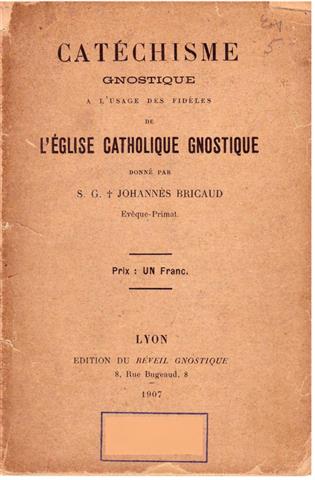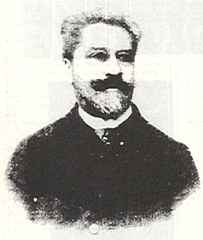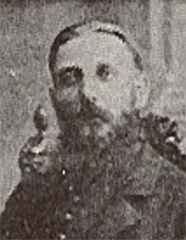ECCLESIA GNOSTICA CATHOLICA
Stranded Bishops
Ordo Templi Orientis
by Peter-R. Koenig
|
While the O.T.O.’s initiatory system is a sort of Kafkaesque bureaucratic club game, it has a religious association under its obedience: The Gnostic Catholic Church. One of the O.T.O.groups intends "to restore Christianity to its real status as a solar-phallic religion" [Aleister Crowley]. In addition to tax advantages, religion supplies a commodity that is always in demand: salvation. And it would seem that some O.T.O.-variations are simply making themselves bulletproof in the context of the law in some countries.
The technical term for the bishopric in the context of the O.T.O. Phenomenon is Wandering Bishop or Episcopi Vagantes. This status is not defined by any character qualities, not by theological education or theological position. These bishops are not elected by a canonical church, nor proposed as an ordain by a suffragan and not bound to a historical episcopal throne or consecrated by an 'official' bishop according to the canonical procedure. Until the Second Vatican Council, the validity of the sacraments alone depends on the correct intention and essential observance of the external rite. Since 1962/65, however, the bishop is no longer the successor of a single apostate, but the episcopal college in its entirety is the successor of the apostolic college. Thus, the Gnostic Bishops are definitely excluded. A 'real' bishop is not a successor of a sole apostle as only the synod/college of bishops in toto are heir to the college of the apostles. Therefore: no Wandering Bishop has a 'real' apostolic succession. There is no Holy Ghost in Wandering-Bishop-consecrations. The instrumentum consecrationis is of no apostolic value. Nonetheless, Wandering Bishops are collectors of papers and diplomas. In all Ordo Templi Orientis versions, the line of succession is vitally important, as it is believed that the leader is the repository of the Order’s magical power, and also has a claim on various copyrights and royalties, especially of Aleister Crowley’s work. | 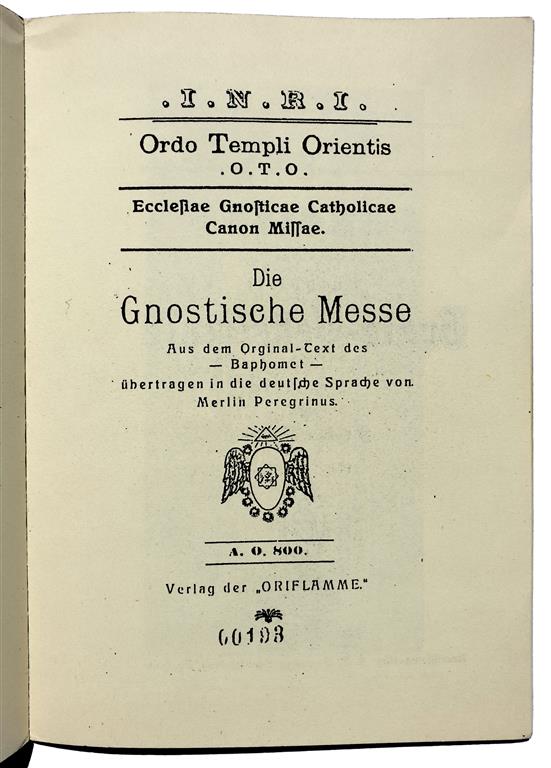
|
|
This article offers a comprehensive compilation of bishops, archbishops, and patriarchs from different denominations, coupled with their affiliations with secret societies, including Freemasonry, Rosicrucianism, and the Illuminati. Analyzing these connections can provide insights into the potential influences that could have shaped the beliefs and actions of these religious leaders.
The article furnishes biographical details of each person, making it a valuable reference for individuals keen on exploring the history of secret societies. By examining the ties between religious leaders and these societies, readers are encouraged to contemplate the wider social and cultural environments in which religious establishments function. However, it is important to approach these claims with a critical and open mind, as the connections between secret societies and religious leaders are often difficult to substantiate and may be based on speculation or conspiracy theories. Nonetheless, the article raises questions about the influence of secret societies on the development of religious beliefs and practices. |
Significant E.G.C. Sequences | 
|
|
1890 Eglise Gnostique founded by Jules–Stanislas Doinel du Val Michel
without apostolic succession. Doinel calls himself 'Patriarch Valentin II'.
1892 Doinel consecrated Gérard Encausse / 'Papus'. 1894 Doinel passed his office on to Fabre des Essarts / 'Synesius'. 1899 Louis–Sophrone Fugairon / 'Sophronius' published a "Catéchisme Expliqué de L'Église Gnostique". 1902 Jean Bricaud / 'Jean II' became a member. 1904 E.C.H. Peithmann published the "Gnostischer Katechismus". 1906 the name 'Église Gnostique' was enlarged to "Gnostic Catholic Church" (EGC, Ecclesia Gnostica Catholica). 1907 Bricaud became head of the Church, and wrote a "Doctrine de la Gnose". 1908 schism. 1911 the Church became allied with Martinism. 1912 Theodor Reuss became Gnostic Legate. 1913 Bricaud received an apostolic succession. 1917 Reuss translated Crowley's Gnostic Mass into German. 1919 Reuss became Gnostic Legate for Switzerland, while Bricaud became a representative of Reuss' O.T.O. 1920 Bricaud wanted to introduce Crowley's "Mass" as the religion for Freemasons. 1921 Bricaud's letter-headings reminded to Reuss's 'Neo-Christian O.T.O.'. 1924 E.T. Kurtzahn named himself Ecclesiarch. 1925 Kurtzahn wrote on the 'Gnostics and the Invisible Church'. 1930 Arnoldo Krumm-Heller met Charles W. Leadbeater. 1934 Constant Chevillon became overall chief of the Church. 1936 Chevillon received an apostolic succession. 1938 Chevillon consecrated Reuben Swinburne Clymer. 1939 Chevillon consecrated Krumm-Heller. 1944 Crowley named William Bernard Crow as head of the Church. 1972 Crow consecrated Kermit William Poling / 'Mar Titus'. "Martinism"1891 re-founded by 'Papus'. 1901 Reuss became 'Inspecteur Spécial'. 1916 Charles Détré became leader. 1918 Bricaud became leader. "O.T.O."1912 Crowley became O.T.O. leader for England and Ireland, and published his "Statutes". 1914 Crowley's "Statutes" published by Reuss. 1915 Crowley described Reuss as "Most Reverend Father". 1917 Reuss called himself leader of the Gnostic Neo-Christian O.T.O. and published new "Statutes" with world-wide applicability. 1918 Supposed split of the French O.T.O. (Jean-Maine). 1919 Bricaud became O.T.O. Delegate. 1919 Crowley, in financial straits, again published his old "Statutes" that were subordinate to Reuss. 1920 Freemasonry broke with the O.T.O. 1920 Kurtzahn participated at Reuss' O.T.O. Chapter-meetings. 1921 Crowley declared himself OHO. 1922 Crowley allegedly met Reuss in Italy. 1933 Peithmann emigrated to the USA. 1948 Crow named himself OHO of the O.T.O. "Memphis-Misraim"1908 Reuss gave MM titles to 'Papus', Bricaud and Détré. 1912 Crowley received MM titles. 1916 Détré became chief of the MM and Martinism. 1918 Bricaud became chief of the MM and Martinism. 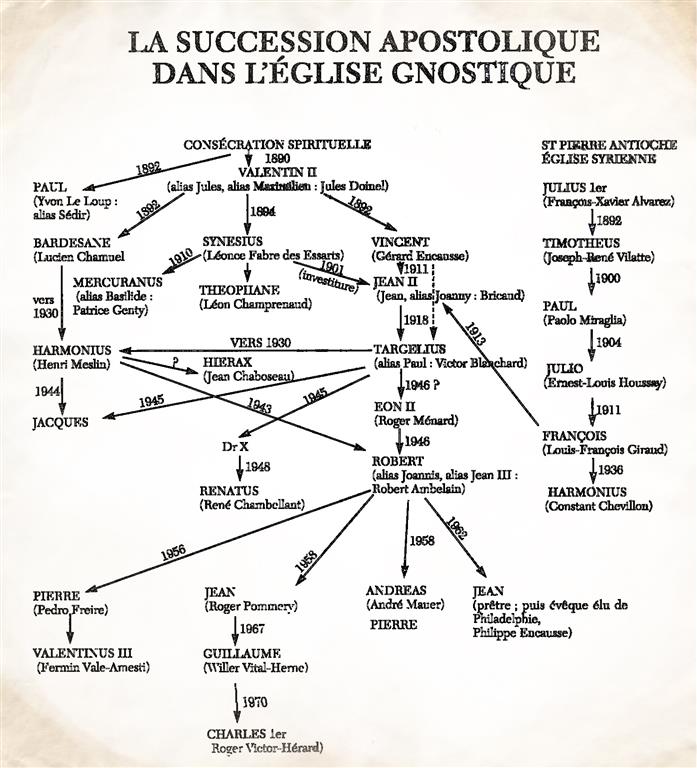
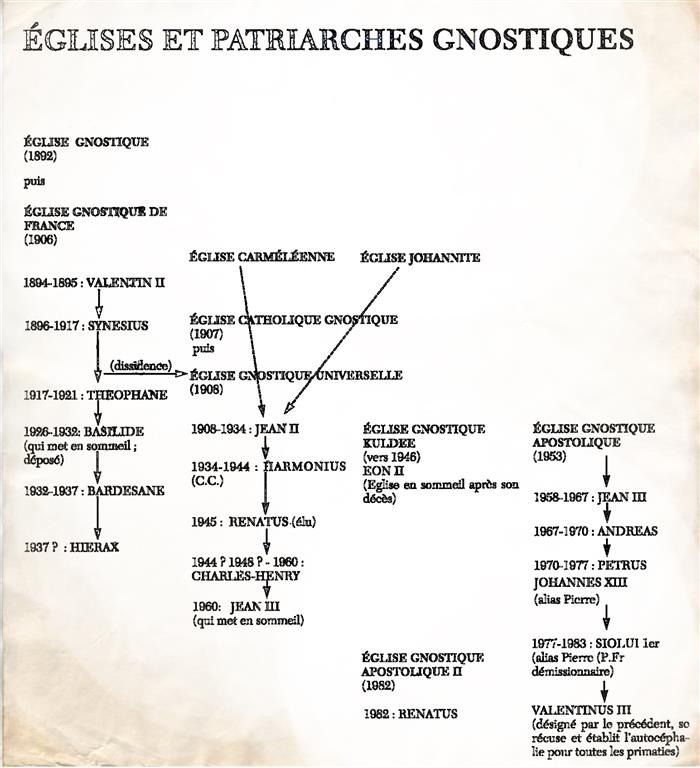
CREEDS OF THE GNOSTIC CHURCHES ASSOCIATED WITH THE O.T.O.
Creed of the Eglise Gnostique Universelle at Lyon, 1908The sermon of H. H. + Johannes Bricaud (Jean II) on the occasion of his appointment as Patriarch of the Universal Gnostic Church in Lyon, 1908.
Lyons, 1908. Creed of the Église Gnostique de France, Paris 1913Marie Chauvel de Chauvigny Esclarmonde (Sophia), from: "Bref Éxposé de la Doctrine Gnostique", Paris 1913. [Allegedly Aleister Crowley wrote his Gnostic Mass in the same year]
T. Esclarmonde S., February 26th 1913. Original: S.-J. Esclarmonde: Bref Exposé De La Doctrine Gnostique, Credo gnostique, 1913 Theodor Reuss: Our Fundamental Tenets, 1913"God and the world (visible and invisible) are an all all-embracing, immeasureable kingdom (the universe), consisting of the known proto-energy (or power of creation), the universe's positive properties, and the unknown proto-substance (or world-egg), the universe's negative properties; which through contact with itself (spontaneous generation, coition) may generate new worlds and creations that are in principle identical, and continue creating such things. And because of our observation that the universe is a twofold thing, positive and negative (also dual), and that 'life' is only maintained by their union, we describe our observation as dualistic world-view.The identity of the creations with the creator lies in the fact that the original power of creation (or power of generation) also dwells in the creations. The ability of the creations to engender further creations of the same sort and breed, through the act of generation (by creation or reproduction) is inherent proof of their (divine) descent from the original creator (or generator). It is in this sense that the words of the Bible are to be understood: 'So God created man in his own image, in the image of God created he him.'" "Oriflamme" of July 1913. Creed of Reuss and Crowley's Gnostic Catholic Church"I believe in one secret and and ineffable LORD: and in one Star in the company of Stars of whose fire we are created, and to which we shall return; and in one Father of Life, Mystery of Mystery, in his name CHAOS, the sole viceregent of the Sun upon the Earth; and in one Air the nourisher of all that breathes.And I believe in one Earth, the Mother of us all, and in one Womb wherein all men are begotten, and wherein they shall rest, Mystery of Mystery, in Her name BABALON. And I believe in the Serpent and the Lion, Mystery of Mystery, in His name BAPHOMET. And I believe in one Gnostic and Catholic Church of Light, Life, Love and Liberty, the Word of whose Law is THELEMA..." Re-translation of Reuss': "'Die Gnostische Messe', Aus dem Original-Text des Baphomet, übertragen in die deutsche Sprache von Merlin Peregrinus", 1917. Facsimile in "Der Grosse Theodor Reuss Reader" Creed of Arnoldo Krumm-Heller's Gnostic Mass"I believe in Mary, Maya, Isis, or those of lesser renown, in the physical force symbolised in Nature, whose conception and illumination reveals the fertility of Nature.I believe in the mystery of Baphomet and the Demiurge. I believe in one acknowledged superior Church, supported by pure souls; in the White Hierarchy, represented by the White Brotherhood, and which has its exponents in the Holy Gnostic Church, ruled by Patriarchs, Apostles, Bishops, and Priests. Our Law is Love, Life, Liberty, and Victory. We have taken the motto Thelema." Arnoldo Krumm-Heller: "Misa Gnostica", no date. Facsimile in the books by P.R. Koenig Fraternitas Saturni: Juste Cruci Suffixus Est"The Light struggles with the Darkness. The Solar Logos fights with the pale demiurge, with Saturn, the lost Son, for the rulership of his realm. Two planets circle our mother-star first in narrow orbits - Mercury and Venus. In esoteric terms they free us from the rulership of Saturn. On the next planet, on our Earth, the battle has been raging for millions of years; it stands at a highly significant intersection within the planetary chain, for the spirit of the Earth is still unredeemed. The outer planets are still servants of Saturn, the Dark Angel. The outcome of this battle is decided in us, in men's hearts."(Karl Spiessberger, "Blätter für angewandte okkulte Lebenskunst", Nº 45, 1953). "But the desire to serve the highest principle of Saturn brings the most profound knowledge. 'Lucifer' as the Morning Star is not only the great fallen Angel Lucifer, but also the brother of Christ. Saturn in his higher octaves is the embodiment of the deepest lessons of maturity through suffering. And within his darkest portal stands the resolution. Saturnus, the guardian of the threshold, then illuminates with a pale light — distorted — the kindness of Jupiter, when his symbol has turned into a mirror-image." (Grosche, "Blätter" Nº 48, 1954). 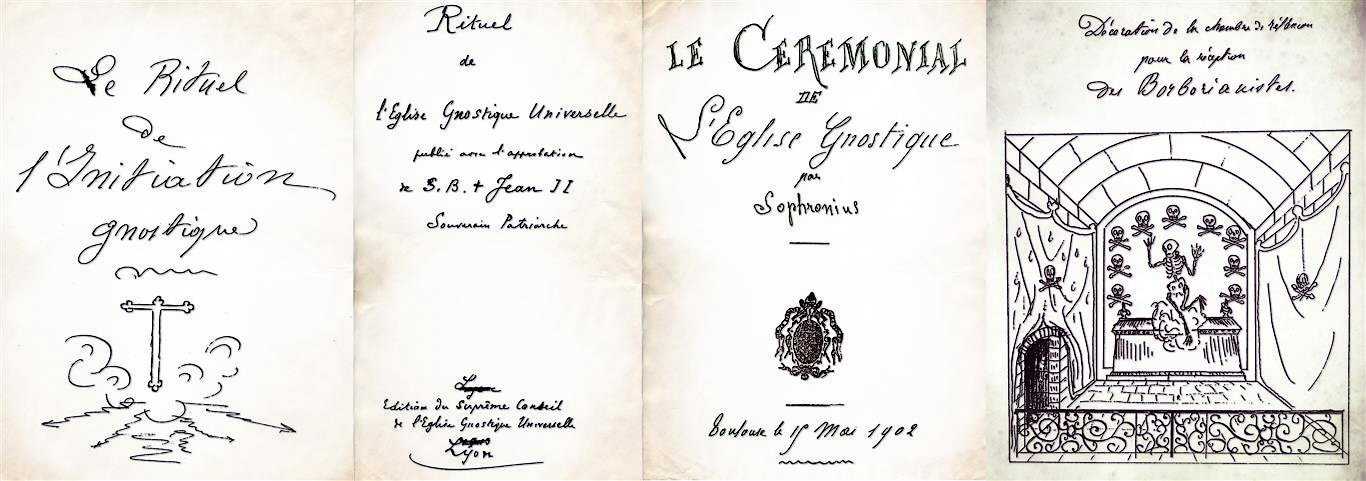

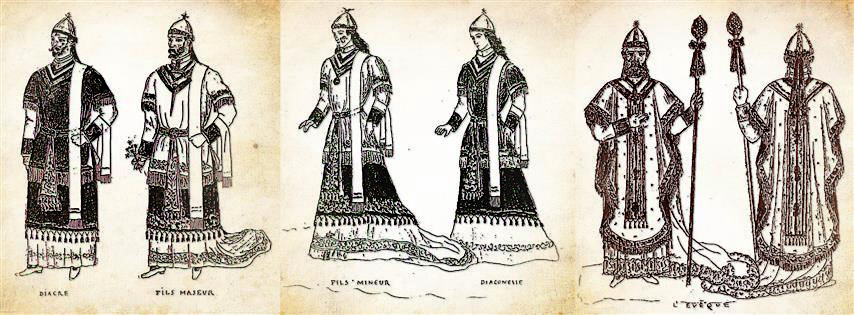

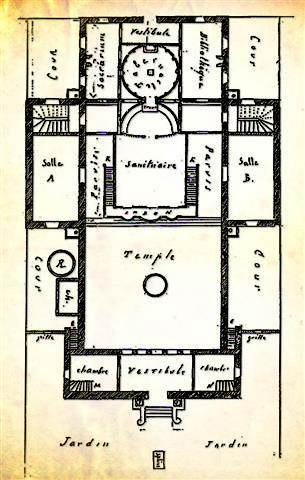
O.T.O. and E.G.C.: For A Pretence, Make Long Prayers [1]It is highly probable that Hermann Joseph Metzger was responsible for linking the O.T.O. phenomenon to the concept of 'apostolic succession', [2] or as he called it, the "Antiochite-Jacobinic Succession, Syro-Malabarite Line of Mar Athanasius since 1877." [3] Today, some new O.T.O.-groups (e.g. the "Caliphate") try to copy this scheme.To understand this claim, the following three (highly simplified) lines of succession should be borne in mind:
(a) Paulose Kadavil Kooran "Mar Athanasius", 1833-1907, legate of Ignatius Peter III of Antiocha, was Syrio-Jacobinic bishop of Kottayam in Malabar. On July 29th 1889 he consecrated Joseph René Vilatte, who took the name Mar Thimoteus I. He was born in 1854 and was ordained on June 7th 1885 as a priest of the Swiss 'Christkatholische Kirche', a branch of the 'Altkatholische Utrechter Union'. Vilatte then proceeded to consecrate a vast number of bishops, but these consecrations and the Orders he founded were not recognized by the Jacobite Church, the Syrian-Antiochan Church or the Roman Catholic Church. Omitting dates and full details, the following line of succession leads to the Reuss-O.T.O.: Alvarez, Vilatte, Gulotte, Hussay, Giraud and Joanny Bricuad (after July 21st 1913). Villatte died in 1929. It should be noted that Vilatte was never a member of any 'Gnostic' Church. (b) On September 21st 1890 (?) a new church appeared overnight in France: Jules-Stanislas Doinel (8.12.1842-16.3.1902) founded L'Église Gnostique based on his encounters with 'Mother Mary"' — as a medium; he called himself Patriarch 'Valentin II'. Doinel had close friends within Theosophy, for example Lady Caithness. [4] In 1892 Gérard Encausse "Papus", who was also a Theosophist, entered Doinel's church. In 1894 Doinel surrendered his office to the Martinist Leonce-Etienne (Eugene) Joseph Fabre des Essarts "Synesius" (1848-1917). In 1901 Bricaud became involved; on June 24th that year Theodor Reuss became Martinist 'Inspecteur Spécial' for Berlin; Papus had refounded Martinism in 1891, and was now its chief. In 1906 the Church's name was changed to 'Église Gnostique de France'. The Church adopted a form of Mass that was described as being similar to the "old Catholic tradition". In 1907 Patriarch des Essarts died and Joanny Bricaud (now 'Jean II') took his place. But in 1908 a Gnostic schism occurred: the branch at Lyon under Bricaud took yet another new name; 'Église Gnostique Catholique' (EGC). Then it changed again becoming the Église Gnostique Universelle (EGU). Meanwhile the original Paris Église Gnostique of Paris had been taken over by Leon Champrenaud "Théophane" though it later disintegrated under Paul Genty "Basilides" in 1926. It is still not certain if Genty was the 'Basilides' who was said to have consecrated Arnoldo Krumm-Heller, or if Krumm-Heller meant E.C.H. Peithmann, who had the same Gnostic motto. (c) Papus remained faithful to his Patriarch Bricaud. In 1911 Église Gnostique Universelle became the official church of Papus' Martinist movement. In 1912 Bricaud made Reuss a "Légat Gnostique" although Bricaud did not receive a valid apostolic (Vilatte) succession until 1913. After Papus died in 1916, Charles Détré took over both Memphis Misraim and Martinism; both were then taken over by Bricaud when Détré's death in 1918. With a repetition of the Gnostic Church's 1908 split, the French O.T.O. fell asunder in 1918. O.T.O. Gnostics and Templars"The 'sacramental' understanding of apostolic succession of consecration is understood as the laying on of hands (in the milieu of a religious service or otherwise) conferring a particular rôle; the document that records this act (the 'instrumentum consecrationis') only had a subordinate rôle. This is in distinction to (pseudo-) Masonry, where the document (the 'Charter' or 'Warrant') has decisive (or even much greater) value, and the act of consecration itself varies, and is to that extent subordinate." [5] On March 15th 1908 [6] Reuss sent 'Papus' a Memphis-Misraim charter, but it mentioned neither the O.T.O. nor the EGC. On June 24th 1908, Reuss bestowed charters on Papus, Détré and Bricaud, which still only mentioned MM titles. [7] On April 21st 1912 Aleister Crowley received a charter from Reuss that nonetheless made no mention of the EGC. [This is important because some alleged Crowley- successors still pretend that Crowley was head of a traditional Gnostic Church related to the O.T.O. while he was only Head of his own created church]. As Bricaud got his first 'traditional apostolic' succession from Giraud in 1913, any possible consecrations in the period before that would only have been of a spiritual nature. Papus died in 1916. At some stage in 1917 Reuss translated Crowley's "Gnostic Mass" into German for "the Gnostic Neo-Christian O.T.O.". In his introduction, Reuss spoke of "the lofty teachings of the holiness of the Divine Organ," and "the godliness of the earthly act of generation, as a parallel of the original divine act of generation." He claimed that "Therefore an act of love consummated under the control of the will in God, is a sacramental deed, a 'mystical wedding with God', a communication, a self-union with God. The holy Mass is a ceremonial, symbolic manifestation of a mystical union of man with God." [8] Reuss described himself in the postscript to this translation as "present Head of the Gnostic Neo-Christians [...] Sovereign Patriarch and Primate of the Gnostic Church", and at the same time as only "Gnostic Legate of the Universal Gnostic Church of France for Switzerland" [9] under Patriarch Joanny Bricaud's leadership. Yet in the same breath he spoke of the latter as identical with the former; quite why remains uncertain. Had Reuss planned to found an independent EGC? In H.J. Metzger's edition of this "Gnostic Mass" Reuss's references to Bricaud, Baptiste, Clement and himself are missing. Reuss made Bricaud (33°, 96°) "délegué générale" of the O.T.O. for France on September 9th 1919; Reuss also granted Bricaud the power to found a Sovereign Sanctuary of the MM 95° in France for the first time, since the charter he had given to Encausse and Détré in 1908 had not been adequate for this. [10] In return, Reuss was made "légat gnostique pour la Suisse" by Bricaud on September 18th 1919. Bricaud and Reuss then revealed their idea of introducing Crowley's Gnostic Mass as a Gnostic religion for the 18° of the Scottish Rite, at the Zurich Masonic Congress in 1920. This led to the final rupture between the O.T.O. and Freemasonry. In 1921 Bricaud's stationary bore the legend "Église Chretienne moderne Néognostique" which was highly reminiscent of Reuss's "Construction programme and guiding principles of the Neo-Christian O.T.O.". [11] One O.T.O. Mass no Church doth make"Even if this ritual [Crowley's "Gnostic Mass" or "Liber XV"] were a lot more satisfactory from both a catholic and a Gnostic point of view, one would be forced to say: 'one Mass no church doth make' ... While there may be honorary degrees of Masonic orders conferred at a distance or 'on sight', this cannot be done in an ecclesiastical succession." [12] Neither Reuss nor Crowley had been ordained in person; ever since it has proved impossible to verify their assertions that they had somehow received 'valid' ordinations. However W.B. Crow was appointed a Patriarch by Crowley in 1944 by post (see below). Although many O.T.O. groups have claimed that Reuss and Crowley had been 'Bishops' and 'Patriarchs' of the Gnostic Catholic Church, and considered the office of 'Patriarch' a prerequisite for the OHO, this still leaves a pressing question about the authenticity of such an assertion. Robert Amadou, in his capacity as an expert on French secret societies, had this to say: The Crowley expert Gerald Yorke said: "Members of the OTO under either Reuss or Crowley were not "ex officio" members of the Gnostic Church in which neither they nor [Karl] Germer were bishops." [14] So by 1912 Reuss had not gained a spiritual succession as a bishop from either 'Papus' or Doinel, whatever he may have claimed. Whether Reuss's MM and O.T.O. charter for Crowley of 1912 was in effect a bishopric as well — or not — it was Bricaud who first got an apostolic succession from Giraud on July 21st 1913. [15] The question arises as to whether Reuss' MM/O.T.O.-charter to Crowley in 1912 (where the term "O.T.O." was put in AFTERWARDS!) could be interpreted as evidencing the conferring of gnostic apostolic succession or not. Since Bricaud only received valid consecration via Giraud for EGU after July 1913, his appointing Reuss a gnostic legate in 1912 was not apostolic. Did Bricaud consecrate Reuss after 1913? If so, did Reuss consecrate Crowley between 1913 and 1914 while they were in London? Did they ever meet afterwards (for example after 1918)? If Reuss did ordain Crowley as an apostolic bishop, it can only have been after July 21st 1913 that the succession might be passed on. After Crowley went to America in 1914, Reuss published a translation of Crowley's essay "Honesty is the best Policy" in May 1915; in the foreword, Crowley is only mentioned as Grand Master of the O.T.O. for England. [16] In the same year Crowley dedicated his "The Giant's Thumb" (New York, 1915) to "the most holy King of the whole Earth, most Reverend Father in the Lord of the Gnostic Catholic Church, Frater Superior O.H.O. of the religious and military order of the temple oriental and occidental" — that is, to Reuss. No evidence has since come to light that Reuss and Crowley ever saw each other face to face after this. At the beginning of 1919 Reuss was re-appointed as Bricaud's 'Gnostic Legate'; once again, the repeated claims that this involved being ordained as a bishop beg the question of whether Reuss then consecrated Crowley in turn — for after 1917, whatever the assertions to the contrary, Reuss employed no further Thelemic O.T.O. rituals, if ever at all. Crowley's diaries between 1914 and 1920 make no mention of ordination as a bishop, or any meetings with Reuss. And when Crowley did describe himself as OHO in his diary on November 27th 1921, he did not mention an ordination, nor is any such claim to found anywhere else in his diaries. Reuss' O.T.O.-statutes of 1917 (of which Crowley's 1919-version, Liber LII, only abbreviates versions already published in 1912 and 1914) do not equate O.T.O. with the Gnostic Church. Crowley's version only says that the "wisdom and the knowledge" of several organisations — including the Gnostic Church — should be incorporated in the O.T.O., but NOT the organisations themselves. Crowley wanted to annex Reuss' office of the OHO and started to quarrel with him. A few days after Reuss forbad him to mix Thelema with the O.T.O., Crowley noted in his diary on 27 November 1921: "I have proclaimed myself O.H.O. Frater Superior of the Order of Oriental Templars." [One month later, Reuss publicly announced himself and Arnoldo Krumm-Heller the heirs to Carl Kellner, that is OHO of the O.T.O.]. Reuss also tied in with Spencer Lewis' A.M.O.R.C. and told him that Crowley was expelled from the O.T.O.. In November 1921, Reuss definitely got rid of Crowley and separated Thelema from the O.T.O. Every thelemic O.T.O. from now on only is a breakaway group from the original O.T.O. Most Thelemites are fervently anti-Christian, so why should they care even if they claim succession from Papus, Bricaud & Co. who certainly were gnostic Christians rather than Thelemites? Valentianism and Catharism which were the foremost inspiratory sources for Doinel & Co. do not involve any "spermatikhos" speculations or practises. Karl Germer, Crowley's heir (in this O.T.O. version), reported that Reuss allegedly met Crowley in 1922 in Palermo, Italy (near Cefalu), but this has not been substantiated by documents or diaries.
Crowley visited Bricaud at Lyons in 1924, and described him "as a kind of Jesus Christ" (according to Henri Birven's account in Metzger's "Oriflamme", Nº 120 of April 1972). But apparently no ordination seems to have taken place, despite the fact that Bricaud had wanted to introduce Crowley's "Liber XV" as the Masonic religion in 1920), no doubt in view of Crowley's expressed antipathy to Christianity (e.g. in "The Gospel According to George Bernard Shaw").
E.C.H. Peithmann and O.T.O.
|
|
"The most important event in the Gnosis must be viewed as sex-magic
[...] proliferation of the glands in puberty or the
intercellular tissues occurs because of nourishment of the germ-cells. Since this
results in stimulation of the ductless glands, the rejuvenation of the
body is a visible consequence [...] In future this will be
imparted at the 'Gnostic Rejuvenation Home' at Südhemmern under the direction of
Dr. E.C.H. Peithmann." [21]
"I swear before the omniscient and omnipresent God, that I will keep secret all the books, lectures, writings and communications received from the gnostic School in Südhemmern; and that I will abstain from fleshly lusts, and seek and lead a pure sex-life; that my sole aim shall be my own improvement, my fellows' welfare, and God's honour." [22] In March 1933 Peithmann was expelled from Germany by the authorities, and fetched up in the USA. From there he never once contacted his followers by letter. "Towards the end of last year [1986] the last living member (85 years old) died. Sadly, Peithmann never got back in touch with the members of his School even after the war. [?]" [23] | 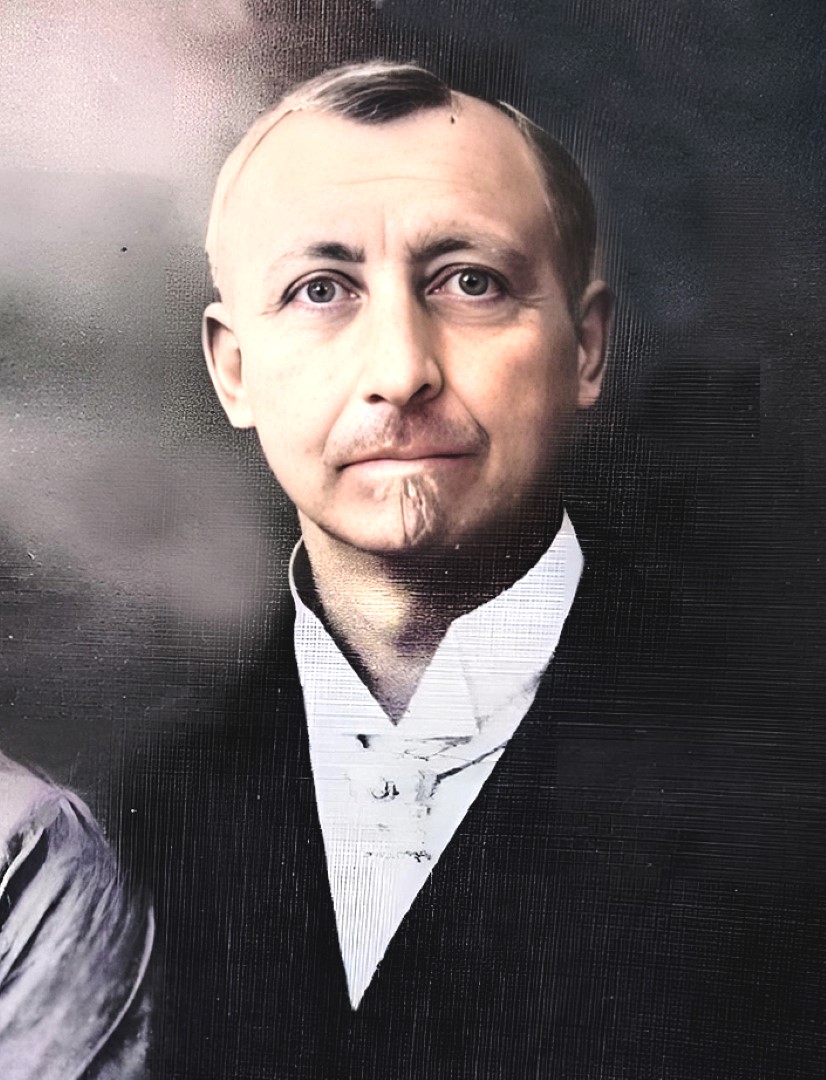
|
|
This last remaining pupil was visited by Dieter Heikaus and Ewald
Dorpheide of the Ordo Saturni, in 1986.
Metzger appealed to his readership through the "Oriflamme" "to furnish us with your biographical knowledge of Peithmann and Kurtzahn." [24] (See Howe & Möller op. cit., p. 181). Ernst Tristan Kurtzahn, (b. 29.11.1879 in Königsberg) was an enthusiastic Ariosophist [25] and author of such books as "Die Rosenkreuzer", and "Der Tarot" (both published in 1920). After 1920 Kurtzahn used the motto "Daiytanus" [26] and participated at Reussian O.T.O. chapters. In the national publication "Der Weltloge" (Nº 1 of 1924) Kurtzahn was announced as 'Ecclesiarch' of the Gnostica Ecclesia Catholica, according to Horst E. Miers. [27] Nonetheless Miers believes that Kurtzahn did not simply become a member of the Fraternitas Saturni (which seems perfectly possible in view of the forty Pansophical members of the original FS), but also co-authored Grosche's "Magical Letters", as well as "Saturn-Gnosis", and even assisted with the draft versions of the FS's rituals. [28] In 1925 Kutzahn's "Die Gnostiker und die unsichtbare Kirche" ("The Gnostics and the Invisible Church") [29] appeared; in its table of contents were such chapters as "The mysteries of sex-magic", "Mysteries of death", and "The opposite Gnostic poles: Woman and the Devil".
Kurtzahn introduced the use of a cross "+" in Order mottos, which was somehow meant to signify that the person concerned had "disclosed the presence of the hermaphrodite soul in themselves." [30] Thus Metzger changed his motto into "+ H. Josephus M.", to resemble Kurtzahn's version "+ E. Tristan K." In the book Kurtzahn made many mentions of sex-magic, and described the Gnostica Ecclesia Catholica as "Eclesia [sic] Mystica et occulta." [31] There was no trace of Reuss or the O.T.O. in the text itself, but in the publisher's announcements at the front of the book, the "Gnostic Mass" and the O.T.O. "Construction Prgramme" were advertised under the rubric "Books about Gnosis." "The ten offices of the EGC are called: 1. Catholic 2. Apostle 3. Hierophant 4. Patriarch 5. Epibomo 6. Primate 7. Metropolitan 8. Archbishop 9. Bishop 10. Presbyter." [32] 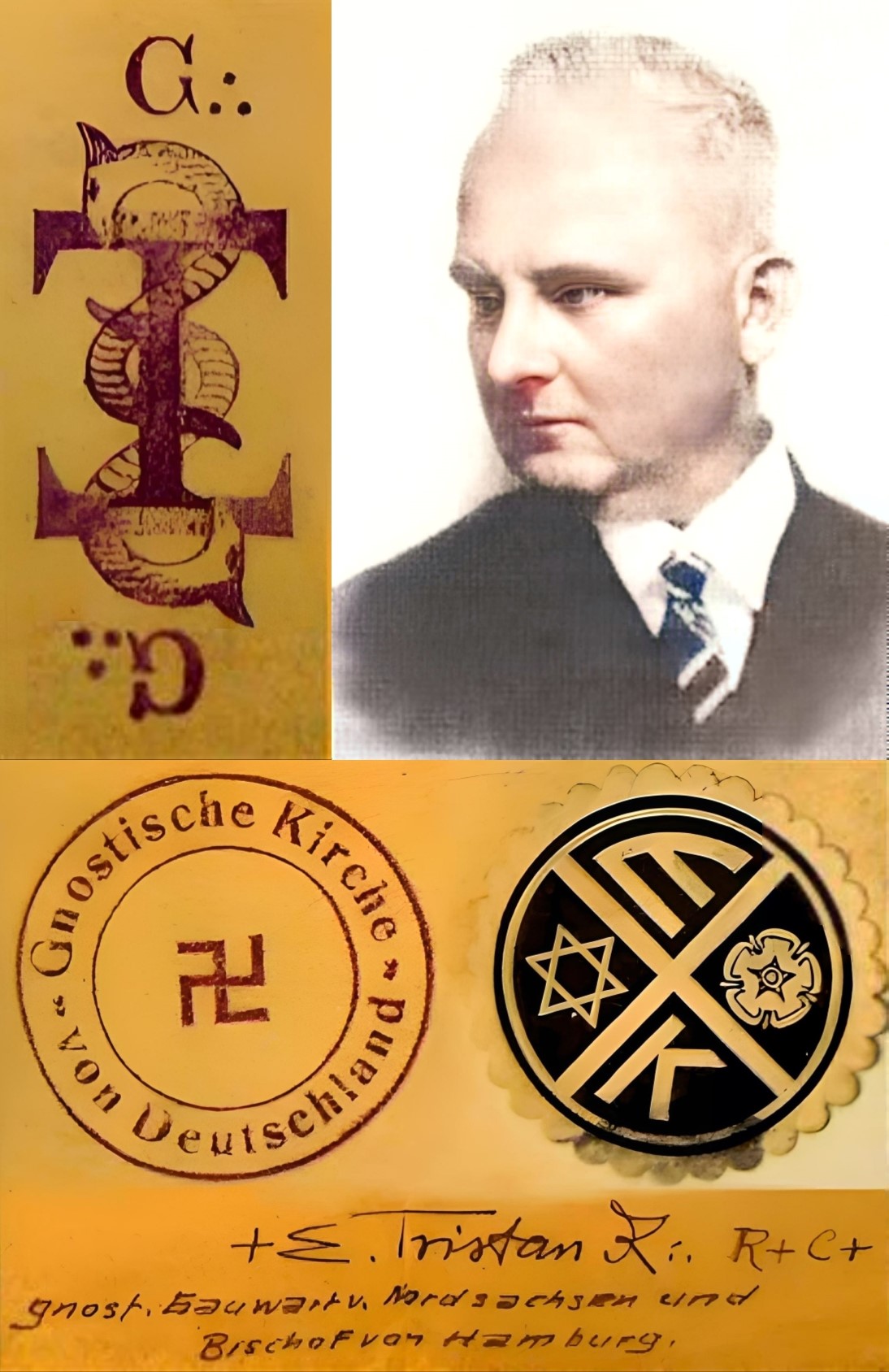
Herbert Fritsche and H.J. Metzger's Ordo Templi OrientisAfter Bricaud's death in 1939, Constant Chevillon became the heir to the Gnostic Catholic Church — in other words to the Église Gnostique Universelle. Ordained on January 5th 1936, Chevillon came from the Villatte line of succession. What he and Reuss's likely heir Hans Rudolf Hilfiker had thought of the O.T.O. may be read in the chapter about them. In 1938 Chevillon consecrated R.S. Clymer, and Krumm-Heller in 1939. "Dr. Krumm-Heller was Bishop of the Gnostic Church, using the English Ritual, and by the death of Peithmann was designated as the Patriarch of the Gnostic Church for Germany-Austria." [33] |
| After Chevillon was murdered by the Gestapo on March (?) 23rd 1944, his Order's archive was sent by a Monsieur de St. Vincent to Swinburne Clymer in the United States. [34] Shortly before his death, Krumm-Heller is alleged to have ordained Herbert Fritsche, who then in turn ordained Metzger (who only had documented proof of his later ordinations) which in this case went hand in hand (that is hand on shoulders) with the supposed leadership of the F.R.A. Markus Kumer, a former Metzger loyalist, had undoubtedly seen Fritsche's handwritten ordination certificate for Metzger, but none from Krumm-Heller for Fritsche. [35] | 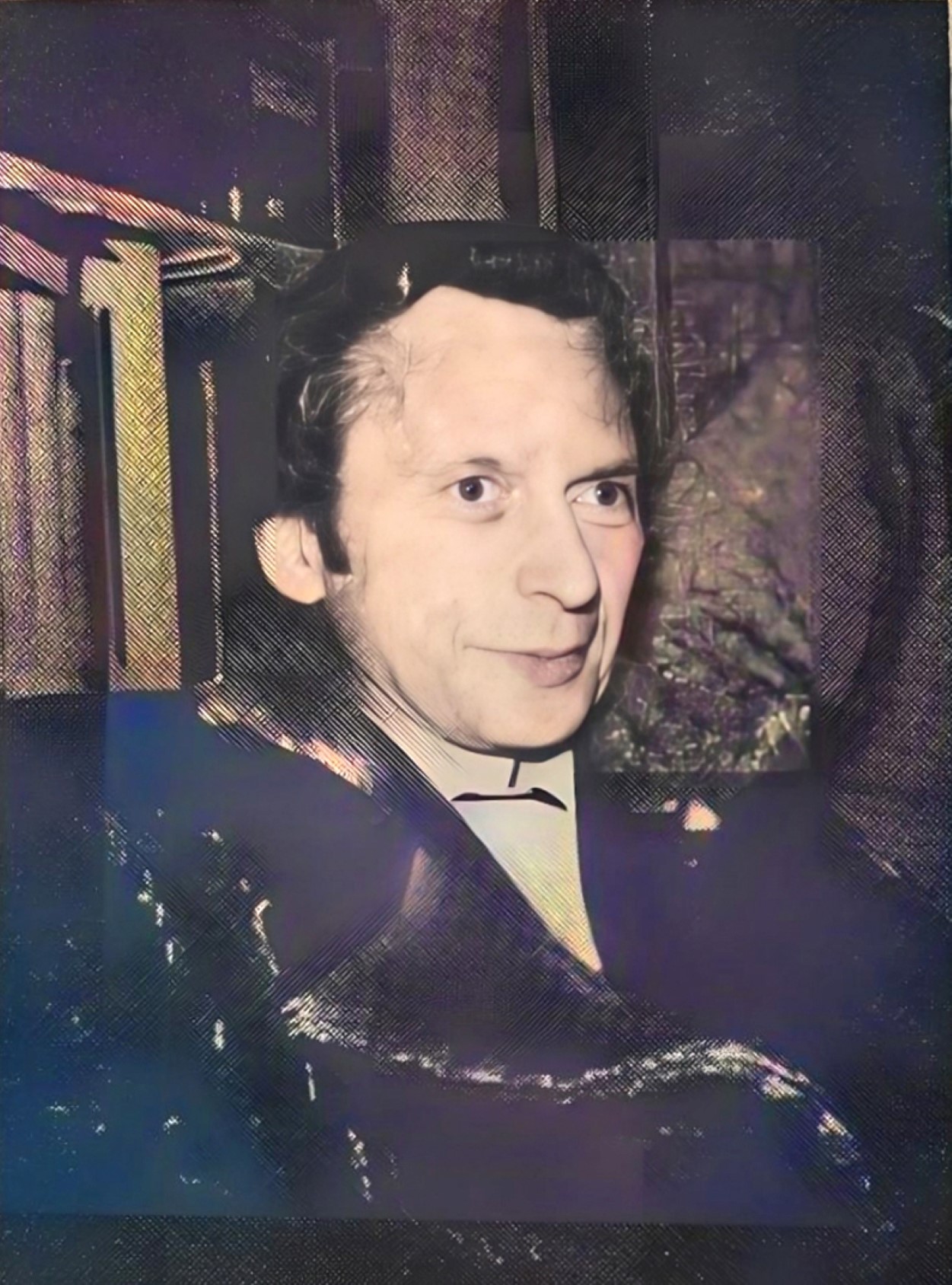
|

Paul Ruediger Audehm about Herbert Fritsche
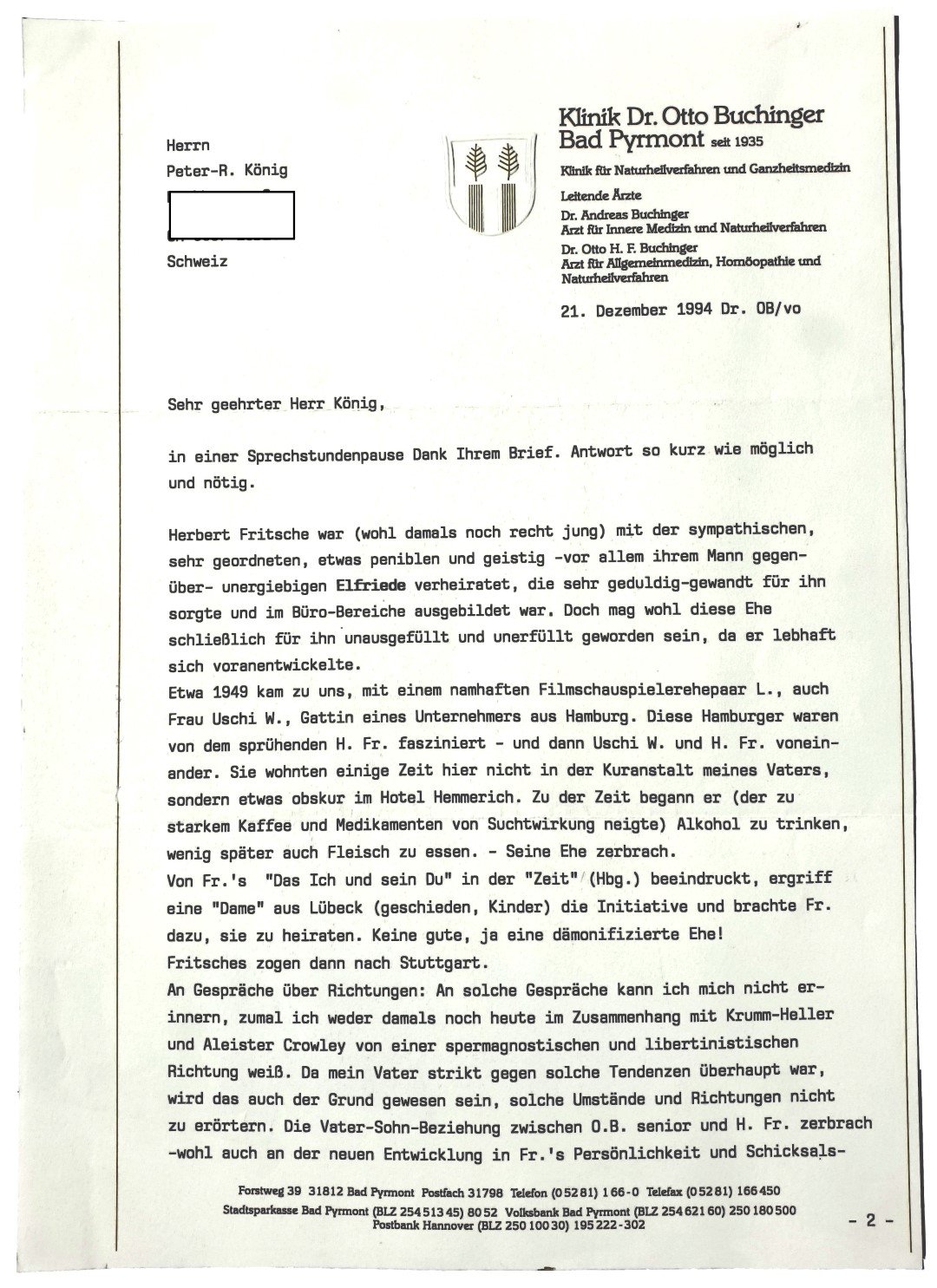
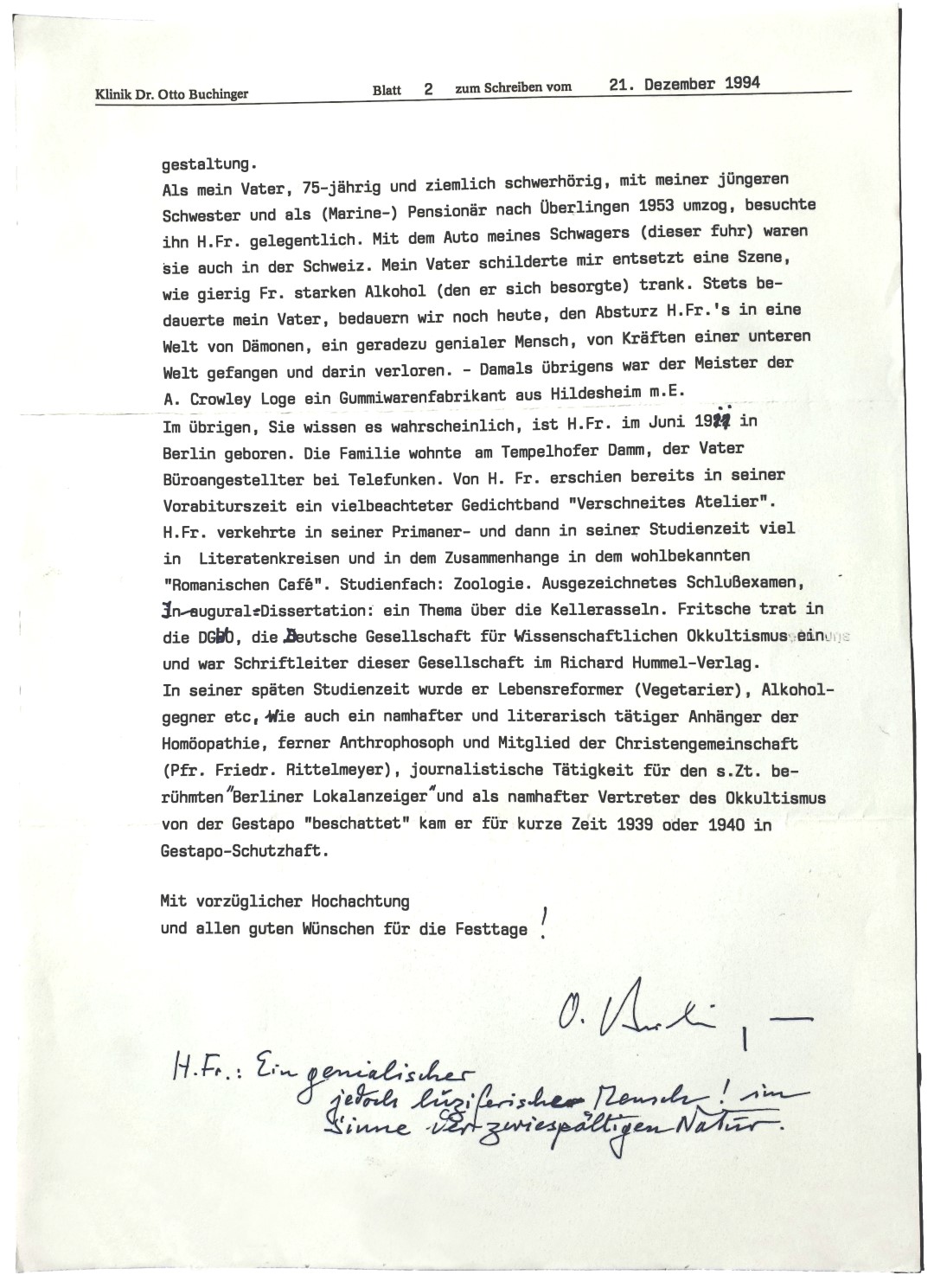
Otto Buchinger, Bad Pyrmont, about Herbert Fritsche
| While Reuss's Gnosticism tended towards Manichæanism, Krumm-Heller leant more towards the Barbelo-gnostics. At Metzger's 'Priest's Seminary' in Stein, the Gnostic scripture "Pistis Sophia" was considered worthy of study. [36] This institution's "Curriculum" included every possible religion, besides directing particular students into a course in "Thelemic theology." The questionnaires included in this curriculum not only asked about one's favourite colours, but also about one's "life-goal." |

Lignée malabare: René Vilatte, Jules Doinel, Theodor Reuss, E.C.H. Peithmann, Arnoldo Krumm-Heller, Herbert Fritsche, Hermann Joseph Metzger.
Drawn circa 1966 by Paul Ruediger Audehm.
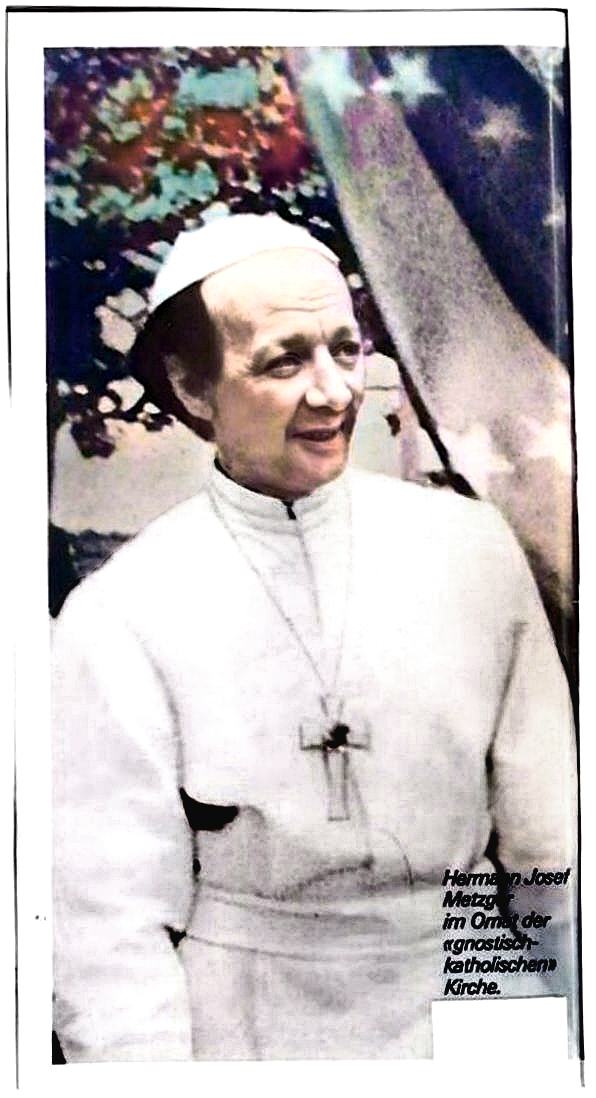
| More photographs and altars and temples. 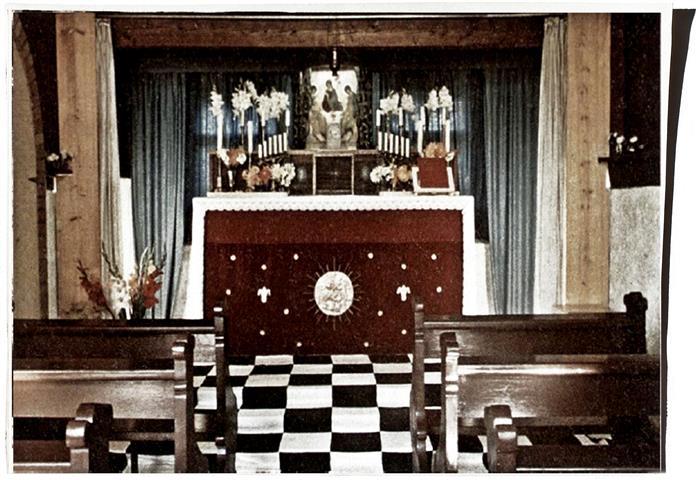
|
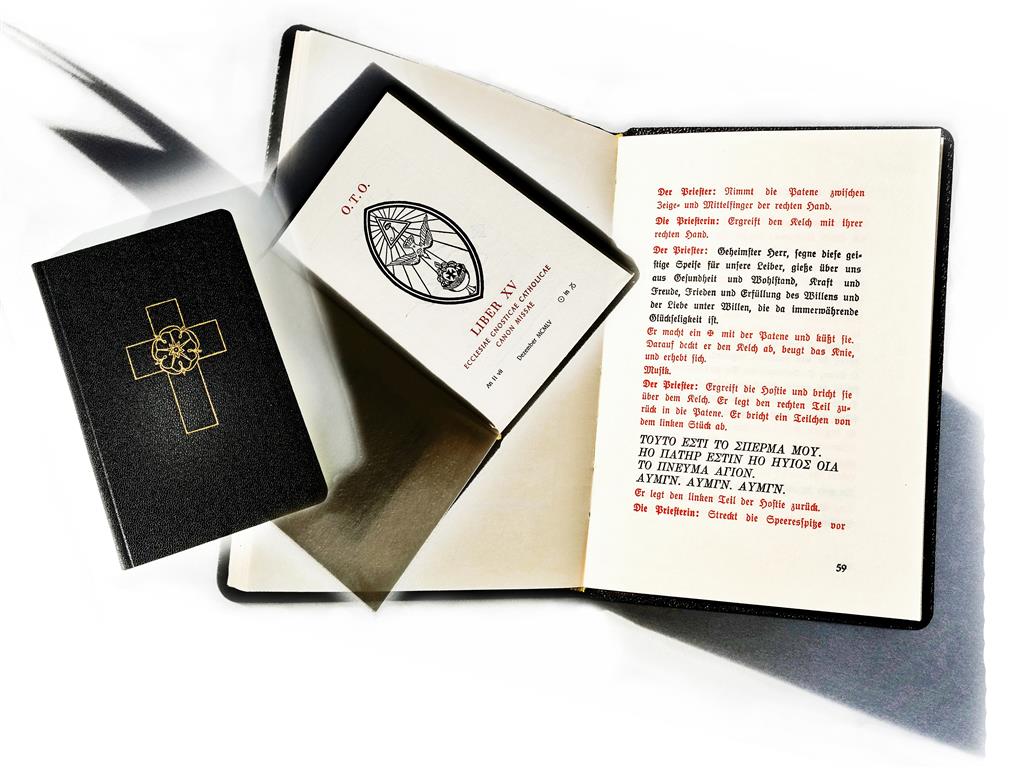
|
In October 1957 Metzger was ordained as a 'bishop' by Fritsche, with
Anita Borgert as a witness.
Seven weeks before his death on the Spring Equinox of 1960, Fritsche passed his position as 'Patriarch' of the EGC on to Metzger. Fritsche died on June 20th 1960 at the Hospital for Nervous Diseases at Haar in Munich — coincidentally, this was the same day as Metzger's birthday. From now on it was said that the "Patriarchate of EGC — this dignity he [Metzger] derived from Chevillon, murdered by the Gestapo in 1944, who was himself the successor of Joanny Bricaud." [38] On the question of the succession Friedrich-Wilhelm Haack said of Metzger: "His forerunner in church offices [Fritsche] ended his life in a Bavarian psychiatric hospital. This was hardly the time or the place to ordain a bishop. Although the present-day Master of this Order has frequently written and spoken of his titles — and has himself performed ordinations — however he has never (to the best of my knowledge) produced any ordination documents." [39] Metzger's project: "The EGC demonstrates the unity of all rituals [...] it is called Catholic [...] because it is all-inclusive," [40] "it is an Ecclesia Sancta Catholica," [41] and "it is the original Minerval Church of the Ordo Illuminatorum," [42] since "the final ranks [of the Psychosophical Society] correspond to the priesthood of the EGC. They are the Illuminati." [43] Now on Metzger's headed stationery, one might find a green symbol of the Equinox, with underneath it the phrase "Priorat Helvetia", and next to that "Gnostisch Katholische Kirche", and underneath that "Église Catholique Gnostique Universelle" as well. |
| Metzger wasn't the first person to try and join various Orders and churches up. The former O.T.O. member under Theodor Reuss's ægis, P. Ch. Martens [44] stated: "The motto is 'Through the Cross to the Crown'. The symbol is the brazen serpent crucified in the desert." [45] When the first convocation of EGC priests took place in 1902, the hierarchy looked like this: "Candidate, Minerval, Magus, Grand Master, Priest, Sovereign (Reuss), Custodian (Engel), Areopagus." [46] Obviously Martens mistook the Order of Illuminati with everything else under Reuss. | 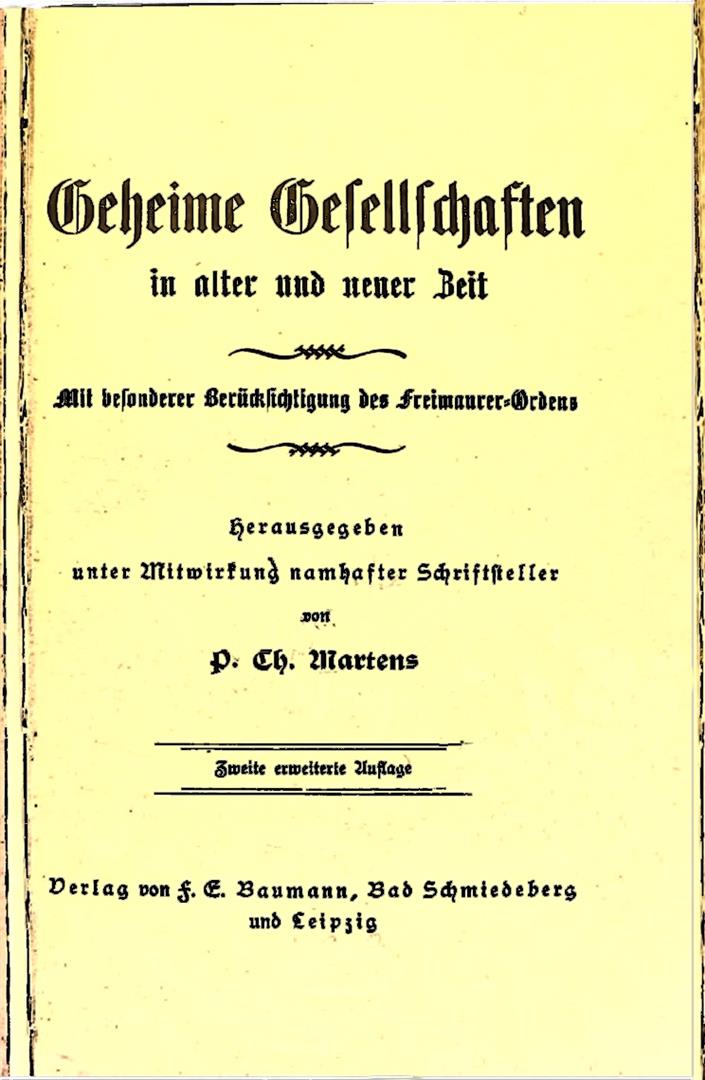
|
|
And Metzger?
"To regain the stolen and misused reproductive power, and to restore it to its proper place, is the work of the Great Mother of the World-Soul." [47] "Do not embrace a naked Marianne or Melusine; she is Nuit herself." [48] "The solution exists in removing one's seed from its terrestrial destiny, and returning it to its original source." [49] "The ends of all the nerves are in the reproductive organs, provided by nature for greater sensitivity, generated by the completion of the sanctified process of union — the orgasm." [50] Metzger left Eugen Grosche in the dark about his conception of the "greatest secret" of the O.T.O., in a letter of October 23rd 1950: "I will neither confirm nor deny anything." Karl Germer himself knew no details about Metzger's position on the O.T.O. degrees involving sex-magic: "What I would like to know is to what extent he possesses the secret literature of the VII°, VIII° & IX°, and knowledge. So far he has been cautious and careful not to say too much." [51] Adolf Hemberger made the following revelation after the appearance of Horst Knaut's scandalmongering reports: "Fr. Paragranus emphatically seperates himself and his OTO from any exoterically practised sex-magic." [52] The "Gnostic Mass" of Walter Englert's apostate" O.T.O.-IO "was orientated towards the Cult of Isis." [53] 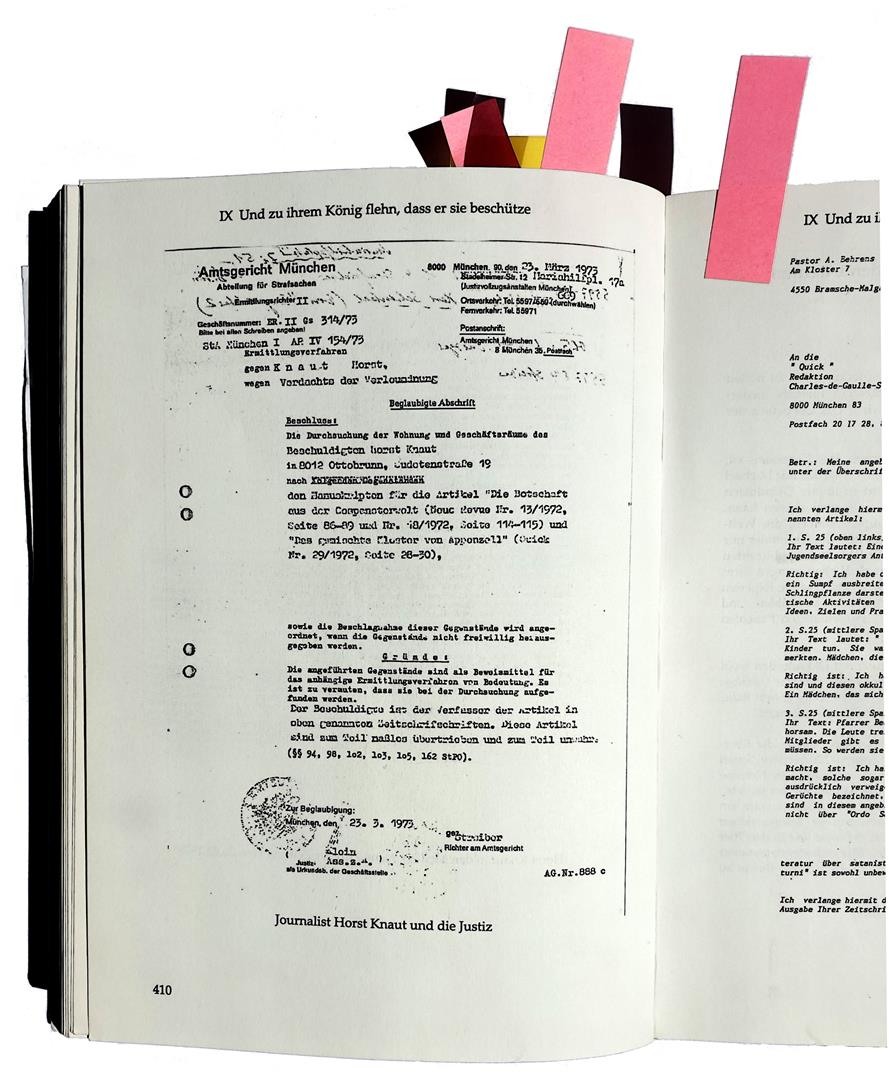
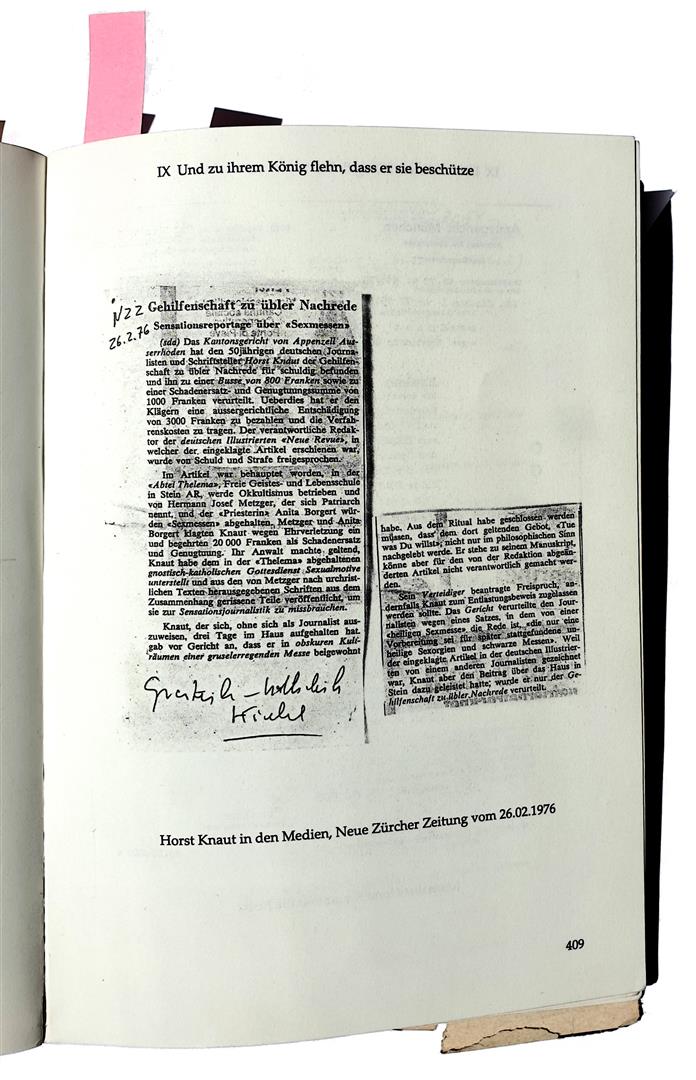
Hermann Joseph Metzger + Anita Borgert (Ordo Templi Orientis) versus Horst Knaut (Journalist) [From: 'SATAN — Jünger, Jäger und Justiz'] Probably as a result of the court cases against Walter Englert and the publication of Ed Sanders's book The Family, which speculated about an association between Charles Manson and the 'Solar Lodge', a hate-campaign against the "bastardised monastery of Appenzell" began in the tabloid press in 1972, led by 49-year-old German journalist and author Horst Knaut. Knaut published various pieces and articles in Quick and Neue Revue about what he described as the "religion of unrestrained lust", quoting from descriptions of sex-magical rituals in Eugen Grosche's Exorial, and the infamous 18° ceremony. As a result of all this unwonted attention, H.J.Metzger and Anita Borgert sued Horst Knaut for libel; his co-defendant was Dr. W. Kuntze, who was the responsible editor at Neue Revue. The two plaintiffs were claimimg 20,000 Swiss francs "with additional interest at 5% per annum since March 25th 1972" as damages and compensation. The court even conducted a "search of the accused, Knaut's, dwelling and workplace," to find evidence during its preliminary investigations. Knaut entered a 'plea of nullity' against Metzger and Borgert at this stage, which meant under Swiss law that he was attempting to halt the trial before it began; but the Swiss Federal Court refused his plea on January 20th 1976. Knaut had to pay combined legal costs and compensation of 1,000 francs. The trial took place exactly one month before the statutes of limitation would have applied, on July 12th 1976 at Trogen, in the criminal court of the Cantonal Tribunal of Appenzell-Ausserrhoden, before five lay magistrates, and Examining Justice Dr. Dörig. The judgement was issued by Chief Justice Hans Schiele; it found the journalists guilty, but only in the matter of one sentence in an article dated February 20th 1975, which spoke of a "holy sex-Mass [...] which was merely a prelude to blasphemous sex-orgies and Black Masses which took place later." Metzger and Borgert lost on seven out of eight counts. Kuntze was given an absolute discharge, while Knaut was only found guilty of helping to compose the aforementioned sentence; he had to pay a fine of 800 francs, compensation and damages of 1,000 francs, legal fees of 3,000 francs (his court expenses came to precisely 1,495 francs and 70 centimes, and he had to pay 400 francs in Swiss duty). Knaut later files an appeal in Lausanne, which is refused on 21 December 1975, which costs him about 400 francs. Now he doesn't want to pay his lawyer the 2,5000 francs but only 1,500. OUTSIDEOn Krumm-Heller's further lines of Gnostic succession, the Chapter on the Fraternitas Rosicruciana Antiqua should be consulted. However Roberto de la Caridad Toca y Medina should be mentioned at this point, with reference to his succession via one Johannes Müller Rider. Gabriel Sanchez Gavíria spoke additionally of a certain Señor Carlos V. Gonzales from Argentina in this connection, besides somebody named "Isidoro". [54]On July 2nd 1977 an Italian from Florence called Loris Carlesi "Tau Johannes" of the Chiesa Gnostica Italiana was entered "in the list of Brothers" for Metzger's Ordo Illuminatorum; Carlesi's line of succession was enumerated thus — Bricaud, Blanchard, Ménard, Ambelain, Brunelli. [55] Metzger never returned the Italian rituals that "Caro Fratello Johannes" had lent him, even though a "collaboration" would have been "auspicious". [56] Meanwhile, a member of Metzger's assemblage of orders called Ian Semmel, originally from Germany, lived in Madrid. 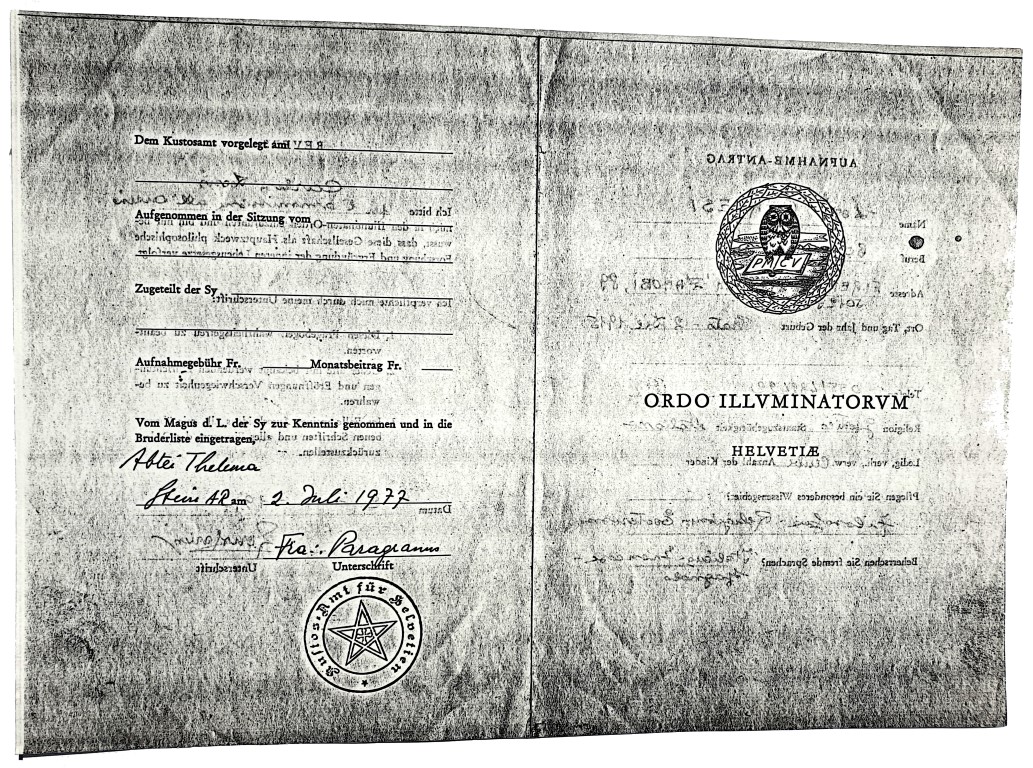
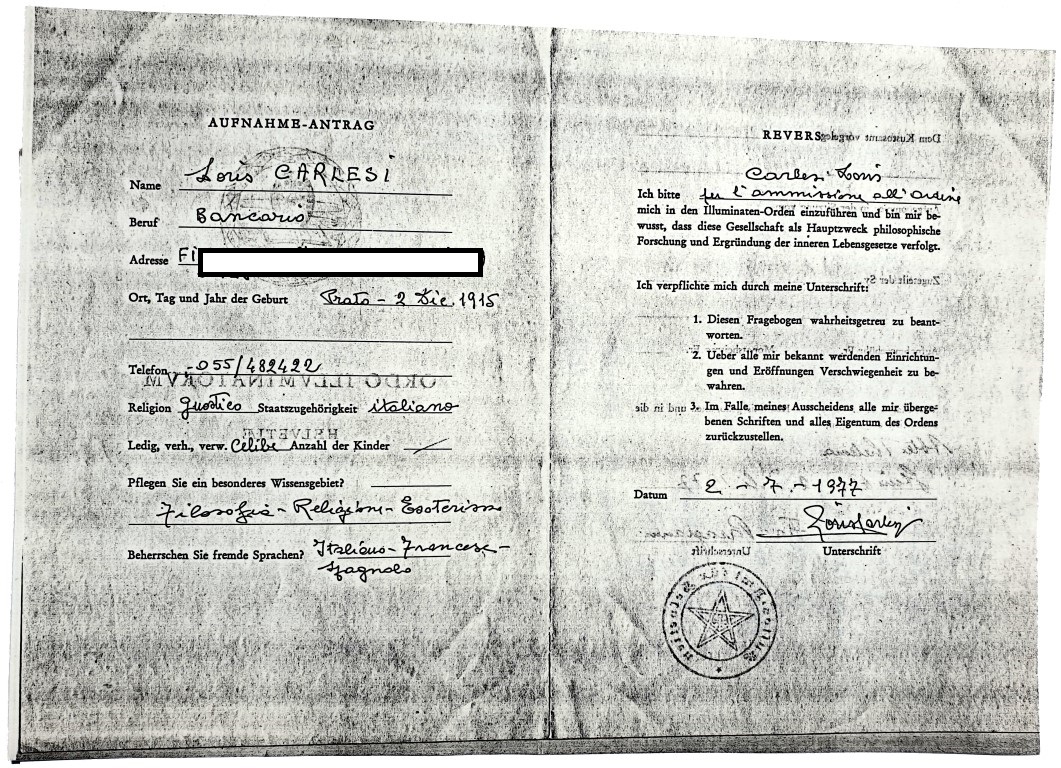
Lucien-François Jean-MaineSince no documentary evidence is available, I only can outline the alleged history as given in several sources (e.g. listed at the end of this article. Born in Haiti on January 11th 1869, Jean-Maine was ordained in Paris on August 15th 1899 by Paul-Pierre de Marraga (of the 'Ecclesia Cabalistica-Gnostica de Memphis-Misraim') and Manuel Lopez de Brion. [57] He was then ordained by Joanny Bricaud (or possibly 'Papus'?) in 1907 or 1908, and re-ordained by either Bricaud or 'Papus' on November 1st 1918 (or 1919). [58] However, in none of the old French EGC/EGU- or O.T.O.-magazines is his name mentioned. [Facsimile of those magazines in "Ecclesia Gnostica Catholica"] The successions preceding Marraga and Brion cannot be elaborated further here on grounds of space, although their line was supposed to descend from a certain "Tau Thesée I" of the 'Église Hieroglyphique des Imagiers' of 1710. [59] Hector-François Jean-MaineHector-François was born in Haiti on November 18th 1924, and was ordained on January 27th 1949 by Robert Ambelain; he was ordained again on January 25th 1953, this time by his father Lucien-François, Henri Dupont, and Ambelain. Ambelain ordained him yet again on November 11th 1959; as if this wasn't enough, he was ordained into the Église Gnostique Universelle as well, by Miguel Sanchez-Marraga, José Marraga y Adhemar and Carlos Adhemar, on November 2nd 1963 — on the same day that Jose Ortier Sanchez y Marr aga ordained him into the Neo-Pythagorean Gnostic Church. Hector-François Jean-Maine received ordinations from Michael Paul Bertiaux on November 2nd 1968, and from Marc-Antoine Lully (though this time he ordained Lully in return). |
Michael Paul BertiauxBertiaux was born on January 18th 1931 (at three minutes to nine in the evening) in Seattle into a family of Theosophists. While his father (described as being of Anglo-Norman and French stock) was interested in Zen Buddhism, his mother (Canadian by birth) was a Spiritualist. Bertiaux studied philosophy and history at the Jesuit University in Seattle, received instruction in philosophy at Tulane University in New Orleans, and learnt about theology at the Anglican Theological Centre in Vancouver. [60] | 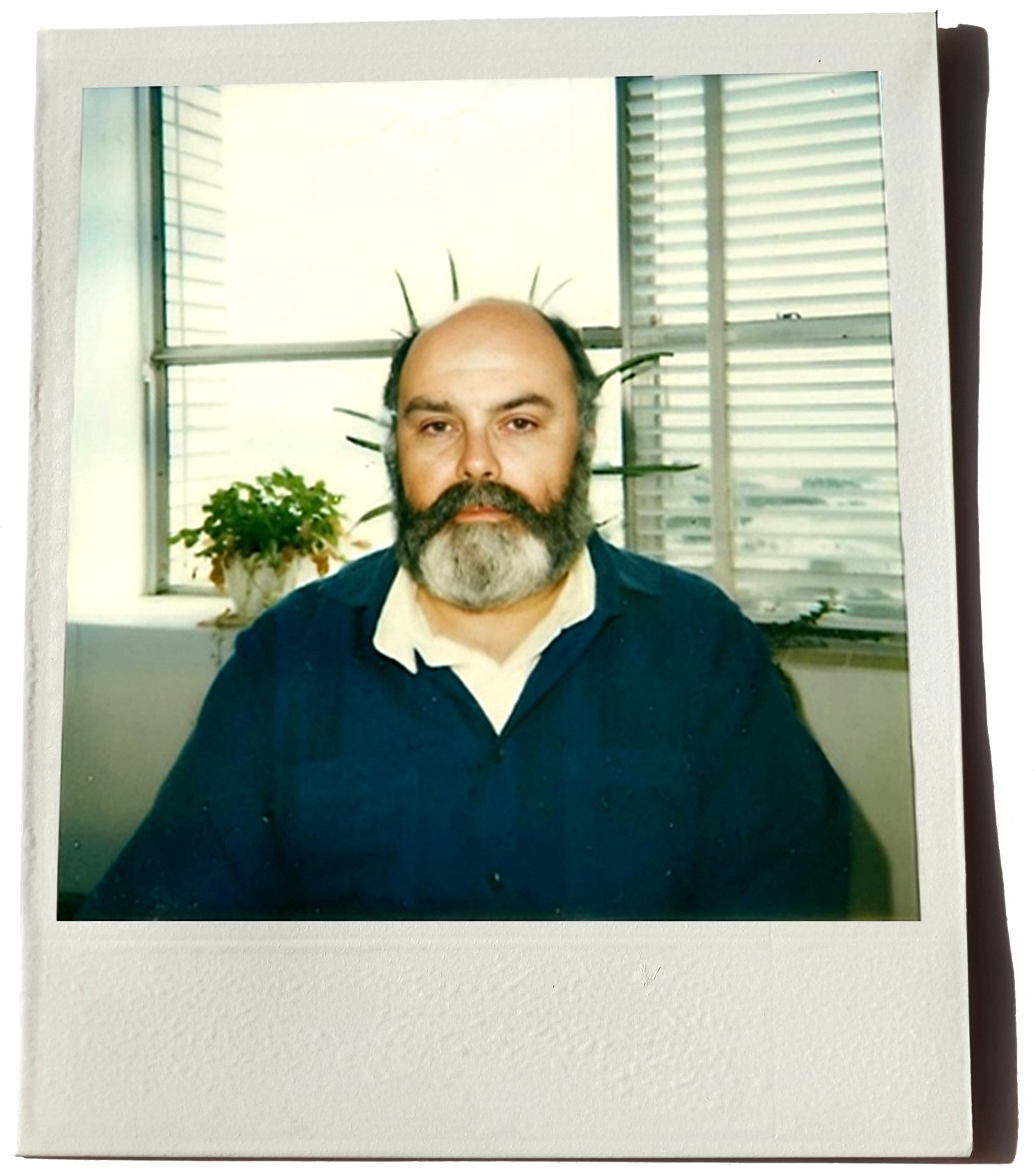
|
|
Bertiaux was christened and confirmed as a Roman Catholic, but was
ordained into the priesthood of the protestant Episcopalian Church on
June 24th 1963. On August 15th that year Hector-François Jean-Maine
appointed him as a bishop at the 'Arc-en-ciel' Lodge, at Petionville in
Haiti. [61] At this time Bertiaux was working at Port-au-Prince as a
philosophy teacher for the Church of England. [62] In Seattle he
became an Anglican Church Commissioner, even though he was maintaining
contacts with Voodoo priests in Haiti. Not surprisingly, he departed
the Anglican fold in 1964, and moved to Wheaton, Illinois, to work for
the Theosophical Society. The TS's president in America at this time
was Dr. Henry Smith; both he and his wife Joanna were interested in
magic and Spiritualism — Joanna was a medium. [63] Haitian immigrants
began to gather round Bertiaux, and he soon devoted most of his
attention to them. During the 1980's was staying in Japan, and devoted
himself to the Shinto religion.
Below are enumerated the various lines of succession that Bertiaux received: Basilides Line: 25.1.1966 from H. F. Jean-Maine und Jose Marraga y Adhemar. 10.8.1967 from Roland Merritt Shreves. 25.12.1967 from Marc-Antoine Lully. 31.8.1968 from Pierre Antoine Saint-Charles. Valentinus Line: 29.6.1973 from Jean-Maine, Adhemar and Jose Sanchez y Marraga. 16.6.1979 from Forest Ernest Barber (Liberal Catholic Church and Mariavite Order). 14.11.1985 from Jorge Rodriguez (besides Bricaud, Blanchard, Menard, Ambelain, Mauer, Pommery, Vital-Herne, Roger Victor-Herard (according to the obituary of 16.8.89 for the "Primate of the Gnostic Catholic Church"), as well as the succession descending via Krumm-Heller, Rider, and Toca). Together with these, Bertiaux mentioned also a "Russian Orthodox from the Patriarchate of Moscow (Patriarch Tikhon to Bishop Ofiosh in 1917)". [65] Gnostic Churches that are offshoots of Bertiaux's activities appear in Spain: Lamparter's Ecclesia Gnostica Latina with a succession from the line of S.A. Höller, Barber, and Rosa Miller. Lamparter's version of the "Gnostic Mass" was held on each "third day of the feminine menstruation", it was a performance, wherein wine (blood) and bread (semen) became magically transubstantiated. [66] In Italy activities were expanded under the guidance of Nevio Viola (in co-operation with Roberto Negrini in the Ecclesia Gnostica Catholica Latina), or else under Paolo Fogagnolo, who had split away from his Order brethren in an attempt to build up his own international organisation; it was intended as a collaboration between all French Gnostics and O.T.O. enthusiasts. (Details on the Italian scene can be found here). In Yugoslavia the 'Ecclesia Gnostica Alba' was led by Zivorad Mihajlovic Slavinski "Tau Orfeo Aivaz I"; he had been ordained by Bertiaux in 1977, and was appointed as X° for Yugoslavia on June 22nd 1990, by the 'Typhonian' O.T.O.'s Kenneth Grant and Michael Staley. Stranded O.T.O. BishopsIn the 'Caliphate's' church newsletter "Gnostic Gnews" Vol. 1 Nº 3, (California 1989, 4) readers would have seen in 1989 the two suppositious lines of apostolic succession claimed by the 'Caliphate': [67]
In conformity with its newly-favoured Christian image, the 'Caliphate' inaugurated new offices of Bishop, Priest, and Deacon. As to point (a), although McMurtry's consecration is supposed to have arrived through the post with the 'Caliphate Letters' from Crowley, there is no mention of this in any of these letters. Martin Starr said: "I consider this 'apostolic succession' argument to be utterly absurd, and have nothing whatsoever to do with the O.T.O. of Crowley, which is founded on Thelema, not the Roman Catholic Church [...] Crowley was not a Bishop of the Gnostic Catholic Church [...] Crowley never "consecrated" McMurtry ANYTHING!" [68] And: "All pre-existing Masonic orders were considered to be subsumed in the OTO, and so he had no need for them [...] For Crowley, Gnostic = Thelemic." [69] There is as little mention of anything about churches or ordination in Reuss's 1912 Charter for Crowley, as in the so-called 'Caliphate Letters'. There is still no proof that 'Papus' ordained Crowley, beyond a solitary reference to the O.T.O. in Berlin and London in 'Papus's' magazine "Mysteria" during 1913; although Reuss was living in London at this time. Moreover, Jean-Maine's name does not appear in any of the French Gnostic or O.T.O. publications. As to point (b), William Wallace Webb "Damon" consecrated Lully by letter in 1967; Lully then introduced Bertiaux into this succession. The highly complex links between Ronald Powell (who also called himself 'Richard Duc de Palatine'), Herman Adrian Spruit, Paul Wadle, Stephan A. Höller and Forest Ernest Barber have had to be omitted on grounds of space. Jack B. Hogg Jr. was ordained on June 2nd 1968 by Bertiaux, assisted by Lully. He was consecrated again on July 24th 1970 by Bertiaux, Frank Lopez O'Brien and Antonio Paez. On August 15th 1973 Bertiaux' OTOA officially accepted the Law of Thelema. On August 12th 1974 Hogg ordained William Breeze - today the 'Caliph'. Again, on July 27th 1980, Hogg was ordained by Bertiaux and Jean-Maine. Breeze himself makes no appearance in the OTOA journals produced at this time ("The Mirror of Misraim", after 1974 "Labyrinthos", and then "Instrumentum"). W.W. Webb stated: "I did give Bertiaux and Lully confirmation to Bishop, by letter, so they would be Legal in the state of Illinois, to satisfy them at that time [...] 1966 or 67." [70] "Wadle never made me a Bishop", [71] merely into a Deacon of the "American Catholic Church." [72] The Gnostic Catholic Church Boast or How William Breeze lost his Apostolic Succession Breeze's response when charged being 'pre-ordained' through the post was "I don't particularly care", [73] though he subsequently revised all his church publications and the ceremony for ordaining bishops to cover his further progress. In the meantime people were reassured with the following claim: "Elevation to the Sovereign Sanctuary of the Gnosis [IX° O.T.O.] "ipso facto" makes one a Bishop, and leadership of such a body "ipso facto" makes one a Patriarch." [74] Armchair O.T.O. Bishops and Kitchen-Sink E.G.C. Priests"The Gnostic Catholic Mass (Liber XV) is the central ritual, public and private, of the OTO (9.05.A)." [75] "The GCC is [...] the Religious aspect of OTO." [76] Regarding Crowley's antidemocratic, racist and misanthropic writings, followers point out: "The reason [...] aspects of Thelema are omitted [in public discussion] indicates the actual problem with presenting Thelema as a religion and attempting to get Thelema sanctioned by the government or approved by the public: Thelema is ultimately in contrast to and transgressive of normative society. Thelema rejects the morals and values of normative society and acts to transgress and violate these norms. From the inclusion of intoxicants in ritual, to the positive view of sexuality, which frequently is seen as promoting promiscuity, to the pro–authoritarian and Nietzschian aspects of Thelema, normative society has much to reject in Thelema and conversely, Thelema encourages its adherents to reject most aspects of normative society.". See The Templar's Reich. The 'Caliphate's' view of the relationship between the O.T.O. and the GCC (EGC) was as follows: "While the OHO is certainly also the Patriarch of the EGC, one does not have to be a member of the O.T.O. to become a priest or bishop in the EGC. On the other hand, a member of the III° is simultaneously a fully ordained priest in the EGC". [77] Breeze: "Note that the other groups that appear in the Oriflamme FRA and EGC, are also component groups of O.T.O." [78] "So far as the GCC is concerned, each national Church is independent; if he wishes, the Chief can call himself a Patriarch, but the OHO is the 'Pope'." [79] "The Constitution of the E.G.C. makes the Caliph Patriarch of the E.G.C., which is technically illegal in the United States." [80] Although the basis for this statement was the legal incorporation of the EGC on October 12th 1979 at Berkeley in California, why hadn't Breeze registered the 'Caliphate' H.Q. in New York as the O.T.O. (at the time when he was living there)? "The Father (or Mother) of the Church has the authority to modify the Gnostic Catholic Mass to suit special functions and occasions, to set recommended guidelines for its proper performance, and to issue recommendations for the preparation of the sacraments (9.05.B)." [81] Although the 'Caliphate' accepted Metzger as X° (as in the "OTO Newsletter" Nº 3 of December 1977), and although no member of the 'Caliphate' had seen a performance of Metzger's interpretation of the "Gnostic Mass": "The Swiss lodge adaptation of the Gnostic Mass is generally held to be too Christian and too tame by the most OTO members." [82] It was around this time that the 'Caliphate' issued instructions to its members to do with preparing 'Cakes of Light' (the Crowleyan name for the Hosts used in the "Gnostic Mass"). If the ingredients included semen, vaginal secretions, and/or blood, they were to be baked at a temperature of at least 160° Fahrenheit, to remove all traces of HIV. [83] (Perhaps this was an error for 160° Centigrade, since 160° Fahrenheit would not bake anything; that would make the correct temperature 325°F, or Gas Mark 3). "Bishops from affiliated or distant branches of the Gnostic Catholic Church with or without an historical connection with the OTO may affiliate with the OTO upon mutual recognition (9.04.B)." [84] This happened, for example with Lamparter, former OHO of the OTOA: "We [...] will register your ordination [...] This confers ecclesiastical membership in O.T.O." [85] After that the 'Caliphate' swarmed with 'Priests' and 'Bishops'. Norbert Straet recalled, for instance: "I was ordained by Bill Breeze and Lon Milo de Quette ('Archbishop' of the E.G.C.) as a bishop". [86] 'His Grace' de Quette was supposedly shot at during the course of a performance of a Crowleyan Mass on November 15th 1987, [87] which however was a 'Caliphate' joke, since in 1991 de Quette undertook bishop-consecrations in Europe. Reference is made to the EGC on page 16 of the Laws of the incorporated 'Caliphate' in Aachen. The Church's Patriarch was placed on an equal footing with the OHO, and even talked of "valid and documented apostolic and episcopal succession." [88] The Great Gnostic Catholic Church ScandalThen displeasure became audible within the 'Caliphate': "Ideally there should be no need in this Æon for a Priestcraft that ministers to some superstitious people and locks them down with some dogmatic tradition of authority [...] stuff coming out concerning the role of Bishops and the EGC — all these rules and regulations for what a Bishop does and doesn't do [...] I wonder if all the officers in the Mass are really capable of handling the Mass." [89] The embarrassing question as to whether "some are holier than others by virtue of being touched by the right hands," engendered "no interest in the sort of Vatican politics [...] the pompous, pious and repressive power-over-you attitudes I encounter from officers of the EGC." [90] Elaine Pagels' "The Gnostic Gospels" [91] which was published at this time, cast a good deal of new light on the original functions of a Gnostic bishop for the 'Caliphate'. The use of purely Christian terms like "Bishop", "Catholic", "Holy Father", and the apparent obsession with traditional apostolic succession apparently left many 'Caliphate' members nonplussed. Some began to ask questions; what would Crowley have thought about such carryings-on? The 'Caliphate's' new "By-Laws" adhered neither to Reuss's spirit nor Crowley's, and offered but a pale imitation of Reuss's presentation of the O.T.O. as a "neo-Christian society." As a result of all these discontented rumblings, Breeze abruptly realised that there was "no evidence in Crowley's or Reuss' papers" to "support the usage 'Bishop' in OTO." [92] This Gnostic "volte-face" stayed on the back-burner for at least a year, until on October 1st 1991 it was announced that the "Holy Ghost" played a part in the ordination of bishops, and that therefore it now regulated the 'Caliphate', and was introduced as part of the VII°. Whether this new perception resolved the urgent question of 'authentic ordination' within the 'Caliphate' remains unanswered; Phyllis Seckler still equated the 'Caliphate's' Ecclesia Gnostica Catholica with the 'Universal Gnostic Church', [93] which only served to provoke further interminable arguments. Put on the alert as a result, Mrs. Seckler tried to prevent her name appearing in this study with threats of legal action. [94] The whole story of why the 'apostolic succession', by laying on the hands, was banned in 'Caliphate' has not been told. David Scriven in an article in 'Red Flame, A Thelemic Research Journal No.2' was jabbing at what the Order 'now' calls Auxiliary Bishops. It's referring to the antics at Thelema Lodge which used to be very, very anti-William Breeze in the mid-to-late-eighties. Many of the members hated their Patriarch. It was no secret they resented someone from the East Coast (New York) taking over the Order after McMurtry's death. They thought William Heidrick (or someone else from California) should have assumed the position and this attitude was fueled by Heidrick's behind the scene activities to that effect. Thelema Lodge, although it has a figure-head type of Lodge Master, has always been Heidrick's Lodge and in many ways, still is. In the "old days" a Bishop was made by 'the laying on of hands.' Each Bishop, although in the Gnostic Church, was autonomous or self-ruling believing strongly in the Creed of the Wandering Bishops. This came back to haunt Breeze who made a lower degree member named David Jones, then Lodge Master of Thelema Lodge, a Bishop. Jones later turned on him. He started making 'everyone' a Bishop by the laying on his hands - for a price. Sadly, many 'bought' their Bishophood for $3.33 and it's no secret Mr Jones and others were simply trying to defy the then newly appointed Frater Hymenaeus Beta (= Breeze), which should say it all. The 'Caliphate' had to put a stop on making Bishops in this fashion and said officially it was no longer recognizing such Bishops. They feared, if a hostile Thelema Lodge was making Bishops like water, it would only be a matter of time before they would be the controlling number of Bishops within the Gnostic Church and not Breeze. The question then arose, "What to do with all these renegade Bishops?" Thus the Order created the term Auxiliary Bishop. This is a term hated by those individuals in the Bay Area who hold the title because it implies that they are not FULL O.T.O. Bishops, a fact they constantly try to hide. To be a FULL Bishop within the 'Caliphate' (now) you must be a VIIth. The majority of the Auxiliary Bishops were below Fourth Degree and few of them have ever risen up to become full Bishops. As the Vilatte-'apostolic succession'line that Breeze claimed until 1990 had turned out to be bogus, in 1993, David Scriven was seeking consecration as a Bishop under Bishop Robert Cokinis and Bishop John Cole (both EGA).
Scriven nevertheless seeked consecration into the EGA and in 1996 found so through Jorge Rodriguez. Rodriguez was consecrated an EGA bishop by Roger St.-Victor Herard. Rodriguez later left the EGA to found his own church, Eglise Catholica Apostolica Orthodoxa. He caused quite a lot of problems for the EGA and the fact that he left was welcomed. The consecration by Rodriguez is not considered valid by any EGA bishops. Rodriguez has been working outside the guise of the E.G.A., so the E.G.A feels that he doesn't have the right to be making Gnostic Bishops even though he shares the same succession that they share. To quote a passage from Bishop Hoeller "We ordain clergy for our own jurisdiction and not for "independent" activities on their own. The Ecclesia has no interest in expansion for its own sake, rather it prefers to have a few parishes led by properly trained priests of true Gnostic commitment." The EGA has very stringent regulations for consecration (e.g. above mentioned issue of Intent). Also, the bull of election is most important. For a valid consecration, there must be a bull of election signed by at least three of EGA Bishops. Rodriguez did not even initiate a bull of election for Scriven at all. — No wonder that only Jack B. Hogg Jr. and Jorge Rodriguez are named as "Bishops in Amity" in the official list of the active 'Caliphate'-Gnostic Church members. Study a version of Stephan Hoeller's Mass that was modified by the EGA's late Primate, Roger St. Victor Herard (Tau Charles). Up to that point, The E.G.A had used a French mass only, and the English mass was basically the Roman mass with a few slight alterations. AND Motta's EGC was led in Canada by a certain "Dominus Harlechinus", of whom however nothing further is knowm. [95] |
W.B. Crow — OHO of the O.T.O.William Bernard Crow (b. 11.9.1895) was a biology teacher, and had been a bishop in the Theosophically-inspired Liberal Catholic Church until 1935, when in August 1944 he was appointed as "Sovereign Patriarch of the Gnostic Catholic Church and Vicar of Salomon with full right, power" etc. etc., in a letter from Aleister Crowley. This settled the question of who headed the church, and would thus celebrate the Crowleyan version of the "Gnostic Mass". In an exchange of letters between Crow and Crowley, it was agreed that in this particular case, an apostolic succession was not required. Crow himself ran something called 'The Temple of Holy Wisdom'. "The psychopath [Crow] having already named himself Bishop of St. Sophia and Grand Master of the Order of Holy Wisdom, demanded that all bishops on the thrones of Antioch submit to him within six months." [96] | 
[Colored with AI] |
|
In fact Crow did only ordaine twice after August 1944: on September
3rd that year, Henry George Brook who exchanged on May 20th 1945
consecrations with H.C. Bartlett, F.E. Langhelt, H.G. de Wilmott
Newmann and John Syer all together. On August 16th 1948 Crow graciously permitted
his followers to appoint him as Grand Heirophant of Memphis-Misraim. His
'Ancient and Universal Rite of Cosmic Architecture' now consisted of
the 33°, 90°, 97°, and the XII° O.T.O.; Crow publicly referred to the
12-degree OTO system as expanded by Crowley, which has already been
mentioned several times in the present work. The XII° was
identical with the office of OHO... exactly as William Breeze copied it
today.
On April 4th 1972 Crow ordained one Kermit William Poling "Mar Titus", who was already Patriarch of the 'Orthodox Catholic Church of America'. It is remarkable that there is not one O.T.O. in the entire world which seems to possess the 'Gnostic' Crowleyan line of succession by itself. Crow departed this life on June 26th 1976. Gregory Tillett stated that "I became Deputy Grand Master of the Order [of the Holy Wisdom] in 1979." [97] The E.G.C. and the Fraternitas SaturniBricaud and Chevillon had early given their gnostic churches a Christian basis, however heretical it might seem. To Reuss and Metzger's way of thinking, the O.T.O. was an association of "gnostic neo-Christians". But Grosche thought that "The real Gnosis had nothing to do with Christian teachings [...] a Christian-oriented Gnosis is today just as objectionable as a religious Spiritualism." [98] "You can't be a Templar Christian or a Catholic Gnostic! They are both the worst sort of mysticism." [99] Thus Grosche separated himself from 'Amenophis's' statement (a high degree FS member) that the Gnostica Ecclesia Catholica was an "ecclesiola in ecclesia", a little church within the Church. [100] This was a pious thought already expressed by E.T. Kurtzahn in 1925 [101], and then by Metzger in 1963. [102] "There is no doubt that Grosche/Gregor A. Gregorius had no proper theological training; he followed an already outdated form of extreme theological rationalism derived from Rénan. The 20th century liturgical movement that sought to blend the knowledge of the Mystery Religions with ecclesiastical forms — as in Theosophy and the Liberal Catholic Church, Anthroposophy and the 'Christengemeinschaft', or in Roman Catholicism with the Benedictine Odo Casel and his 'Theology of the Mysteries' — all this passed straight over Grosche's head." [103] Dieter Heikaus, the Mariavite Bishop of the Gnostic Catholic Church in Germany (which apparently only had an existence in the OS circulars) and Grand Master of the Ordo Saturni, used these circulars to found a 'Secular Saturn Monastery', at the Spring Lodge meeting in 1990. [104] Grosche had already talked about this Monastery, built "according to Saturnian" laws, in his "Blätter für angewandte okkulte Lebenskunst" (Nº 44 of September 1953); before the Second World War certain FS brothers from Brüx in Austria, and the Obersalzberg (where Hitler had his retreat), had placed building-site at his disposal. Metzger's O.T.O. and Christendom"The Roman Church is just one Order among many." [105] "The greatest treasure that mankind has ever gained is Christ's teaching." [106] "Christmas Eve brings Light [...] through Night to light!" [107] One of Metzger's innumerable titles read thus: "+ H. Josephus M., Patriarch of the Holy Gnostic-Catholic Church 'Ecclesiola in Ecclesia'." In his "Oriflamme" Nº 28 of June 1963, after the death of Pope John the 23rd Metzger tearfully recorded: "we are touched." When Pope Paul the 6th was enthroned, Metzger sent a congratulatory telegram to the Vatican; the Swiss Ambassador to the Vatican was informed. [108] "Metzger wished his EGC to be known as an ecumenical movement." [109] However, he did not express this wish to the established churches, and the Evangelical-Lutheran Bishop of Bavaria wrote to him in dismissive terms: "The centuries-old tradition that you claim for your group bears no relationship to fact. Hence your group has nothing to do even with other groups of similar names. Your activities are not supra-confessional. Nothing is known of your claims about your 'ecumenical collaboration' with other churches, and there is no church in the Ecumen that maintains any sort of contact with you." [110] The office of the See of St. Gallen added: "that on our part we have never expressed any opinion to do with the Psychosophical Society." [111] In reality, what Metzger meant by 'ecumenical' was almost entirely predicated on his association with one Erich-Viktor Beyer "Father 'Adalbert Maria'", who had been born on September 4th 1911 in Danzig. Authorities recorded that he lived in Germany, at Böhringen near Radolfzell, and that he had spent many years as a "wandering Russian Orthodox monk", gaining admission to Catholic monasteries, convents, and other institutions, where he celabrated High Masses in Latin — and had got hold of the fees for these Masses. [112] "Metzger called him a 'one-man monastery'." [113] Beyer died as a result of a heart-attack, and was buried at the Ostfriedhof in St. Gallen on December 19th 1967; a large delegation from the Stein Abbey of Thelema participated at the event, resplenently clad in their Order robes, led by 'Episcopus' Metzger. [114] In Beyer, Metzger saw an "uncompromising ecumenical [...] this wandering charismatic bore his burden with stoical equanimity from the North Sea to the Mediterranean, and from east to west." [115] "One time that he was with us [Paul R. Audehm and Walter Englert] in Frankfurt, he said in deadly earnest about M[etzger] — who was sitting at the same table — 'He is a devil'. They were both on the way to Wiesbaden, and both of them had a sword in their baggage [...] There must have been a secret Templar convent in Wiesbaden, but not the OM[C]T [Ordo Militiae Crucis Templi], where we'd heard of the former General of the Order [Hans Heuer] [...] In 1968 at Englert's house, many Catholic Sisters from Frankfurt came to see Beyer [...] This 'Father Strangelove' was buried according to the 'Gnostic Catholic Rite' in the presence of everyone from Stein, so I heard." [116] Because Metzger's telegram to the Pope "had been noticed, in 1963 I began a colllaboration with Prof. Dr. P. Gebhard Frei [117] (d. 27.10.76) for research and to collect information." It was detected how many Hosts Metzger used in his Masses: "1963-1967 = a total of 3,000 Hosts," [118] "obtained by the Thelemites from a genuine Catholic convent. The incense-grains had already been opportunely supplied by the Chief Sacristan of St. Gallen Cathedral. And the wine for the Mass, says Hermann Josef Metzger, came directly from the Bishop." [119] |
|
"GNOSTIC-CATHOLIC CHURCH, Zurich, Nº 64610. Church Wedding: The church
wedding of the bride and groom [Walter and Uta Englert] [...]
was
performed on the 31st of May 1964 in the Rosy+Cross Church of Zurich by
His Eminence Bishop Josephus." [120] The Chief of Police for Zurich Canton believes that this marriage was worthless in civil terms; however Metzger didn't actually break any laws. [121] | 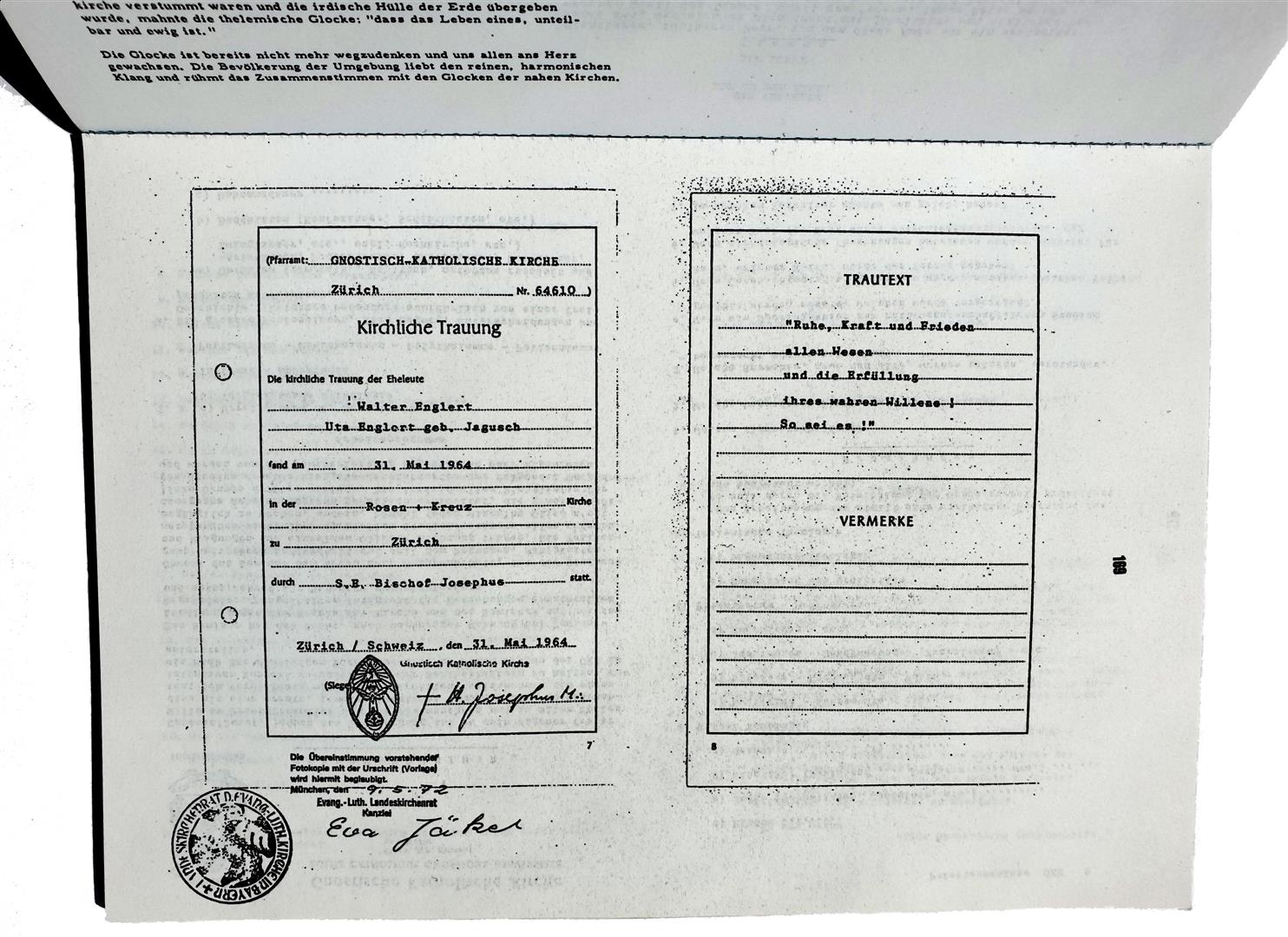
|
|
When Fritz Blanke's book "Kirchen und Sekten" ("Churches and Sects")
appeared in 1963, with its statement that "the Psychosophical
Society has allowed the ritual of a blaspheming Mass to be printed" (p. 91)
they raged in Stein against this "Ukase from a professorial
priest."
[122] Blanke died in 1966, and in 1973 the Psychosophical Society
opined that "Professor Blanke had [...] given us friendly
advice up until his death." [123]
The Professor's son could not supply any further details: "I know of no other statements of my father's" book (Letter of 18.11.86). Oswald Eggenberger was then requested not to mention the O.T.O. and EGC in the next edition of his guide "Kirchen, Sondergruppen und religiöse Vereinigungen" ("Churches, Independent Groups, and Religious Societies)" because "it is only a question of a tiny membership." [124] After announcements about the EGC appeared in the "Kirchenbote der Stadt Zürich" ("Zurich City Church Courier"), one reader wrote in enquiring about it. The paper's reply describing the O.T.O., saw it as being "a remarkable muddle" and a "supermarket of religions", while its references to primitive Christianity were "pure folly". ("Kirchenbote der Stadt Zürich", December 1964). On Horst Knaut's appointment by F.-W. Haack, the "Oriflamme" (Nº 132 of 1973) complained to the Bishop of the established Evangelical church". Haack had this to say: "The established Church generally did not respond to this matter, because that kind of initiative was not taken too seriously." (Letter of 15.9.86). On dealing with those who resigned from a church, from the Christian perspective: "Resigning from a church is never required, notwithstanding someone's devoting themself to particular groups by themself (here the Psychosophial Society is meant, which considers itself as the successor to the Rosicrucians)." [125] "Provided the people from the Abbey of Thelema [...] made no claims being a proto Christian Society with a religious tradition, then one could afford to ignore them." [126] Notes to Chapter Fifteen of "Das O.T.O. Phänomen" (1994)
Due to the most complicated interconnections of dates and events I must refer the reader to the following sources. When not footnoted in the text I refer to these books. Data without references are from: Alan Bain: "Bishops Irregular", Bristol, 1985. G Ward, Bertil Persson, Alan Bain: "Independent Bishops", Michigan 1990. Gordon J. Melton: Encyclopedia of American Religions, Detroit 1987. Henry R.T. Brandreth: "Episcopi Vagantes", London 1947. P. Anson: "Bishops at Large", London 1964. R.S. Clymer: "The Book of Rosicruciæ", Vol. I Quakertown 1946; Vol. II 1947; Vol. III 1949. (As opposed to Clymer's "Rosicrucian Fraternities in America"). Serge Caillet: "Franc-Maçonnerie", Paris 1986. Gerard Galtier: "Maçonnerie Egyptienne", 1989. René Le Forestier: "L'Occultisme en France... L'Eglise Gnostique", Milan 1990. Robert Amadou's foreword in Jean Kostka: "Lucifer Démasqué", Geneva 1983 (originally 1895). Ivan de la Thibauderie: "Eglises et Evêques Catholiques non Romains", Paris. Jan Steperov (Prévost): "La Succession Apostolique", Paris 1992. Edmund Platzinski: "Mit Krummschwert und Mitra", Augustin-Buisdorf 1970. F.-W. Haack: "Gottes 5. Kolonne", Augsburg 1977. Haack: "Freibischöfliche Kirchen", Munich 1980. Haack: "Religion und Dekoration", Munich 1990. Karl Frick: "Licht und Finsternis II", Graz 1978. Ellic Howe & Helmut Möller: "Merlin Peregrinus", Würzburg 1986. Lines of succession in as published in "AHA" magazine, November 1991, p. 6ff.; facsimile in Koenig: "Ecclesia Gnostica Catholica", 1998 Translated and adapted from a chapter on the O.T.O. Protagonists in "Das O.T.O.-Phänomen" (1994) by Mark Parry-Maddocks — German original online. A very tiny outline can also be found in the English "O.T.O. Rituals and Sexmagick" (1999) Traduction français: Les Évêques Errants. More about all this in Andreas Huettl and Peter-R. Koenig: Satan — Jünger, Jäger und Justiz
|
|
Facsimiles of many documents: Ecclesia Gnostica Catholica
Main page on the Gnostic Churches
Pictures + Documents
To the other Chapters of the English online version of "The O.T.O. Phenomenon" book
O.T.O. Phenomenon navigation page | main page | mail
What's New on the O.T.O. Phenomenon site?
Scattered On The Floor
Browsing Through The Rituals
